Mechanical Characterisation of Single-Walled Carbon Nanotube Heterojunctions: Numerical Simulation Study
Abstract
1. Introduction
2. Materials and Methods
2.1. Geometric Definition of SWCNT HJs
2.2. FE Modelling
2.3. Loading Conditions
3. Results and Discussion
3.1. Rigidities of SWCNT Heterojunctions
3.1.1. Parametric Study of Rigidities of SWCNT Heterojunctions: FE Analysis
3.1.2. Rigidities of SWCNT Heterojunctions: Analytical Solution
3.1.3. Analytical Study for Evaluation of the Rigidities of SWCNT Heterojunctions
3.2. Comparison with Literature Results
4. Conclusions
- For heterojunction with the same difference between the diameters of the wide and narrow nanotubes, ∆D, the tensile rigidity decreases with the increase of the HJ aspect ratio, following an exponential trend. The same type of trend occurs for the evolutions of the bending and torsional rigidities with the HJ aspect ratio.
- The tensile, bending and torsional rigidities increase with the increase of the average HJ diameter. The evolutions of the tensile rigidity follow a quasi-linear trend for heterojunctions with ∆D = 0.678 nm (armchair–armchair) and ∆D = 0.392 nm (zigzag–zigzag); but for greater differences between the diameters of the wide and narrow nanotubes, the tensile rigidity evolution are close to a second degree polynomial trend; this different behaviour is most likely linked to the occurrence of redundant bending deformation during the tensile test. The evolutions of the bending and torsional rigidities with the average HJ diameter are close a third degree polynomial trend.
- Equations (9)–(11) (together with Equations (12)–(14)) offer a robust method for easily assessing the tensile, bending and torsional rigidities of HJs in a wide range of their geometrical parameters, were recommended. The accuracy of these analytical solutions was successfully tested on current results as well those available in the literature.
Author Contributions
Funding
Conflicts of Interest
Appendix A
| Force/Moment Application | (n1, m1)–(n2, m2) (n1, 0)–(n2, 0) | η | ΔD, nm | (EA)HJ nN Equation (6) | (EA)HJ nN Equation (9) | Difference % | (EI)HJ nN·nm2 Equation (7) | (EI)HJ nN·nm2 Equation (10) | Difference % | (GJ)HJ nN·nm2 Equation (8) | (GJ)HJ nN·nm2 Equation (11) | Difference % | |
|---|---|---|---|---|---|---|---|---|---|---|---|---|---|
| force (moment) applied on wide SWCNT | (5, 5)–(10, 10) | 1.940 | 1.018 | 0.678 | 308.04 | 308.36 | 0.10 | 50.24 | 51.25 | 2.01 | 74.20 | 72.04 | 2.91 |
| (5, 5)–(15, 15) | 2.912 | 1.357 | 1.357 | 101.61 | 101.65 | 0.04 | 51.07 | 53.44 | 4.65 | 81.17 | 78.81 | 2.91 | |
| (5, 5)–(20, 20) | 3.496 | 1.696 | 2.035 | 48.11 | 48.10 | 0.02 | 51.41 | 55.19 | 7.34 | 83.65 | 81.21 | 2.91 | |
| (10, 10)–(15, 15) | 1.166 | 1.696 | 0.678 | 1194.04 | 1206.19 | 1.02 | 384.92 | 396.14 | 2.92 | 510.75 | 511.75 | 0.19 | |
| (10, 10)–(20, 20) | 1.943 | 2.035 | 1.357 | 609.46 | 618.36 | 1.46 | 394.96 | 417.75 | 5.77 | 591.45 | 595.34 | 0.66 | |
| (10, 10)–(25, 25) | 2.501 | 2.375 | 2.035 | 306.53 | 335.28 | 9.38 | 411.65 | 433.78 | 5.38 | 628.44 | 634.98 | 1.04 | |
| (15, 15)–(20, 20) | 0.833 | 2.375 | 0.678 | 2125.05 | 2150.45 | 1.20 | 1270.42 | 1311.34 | 3.22 | 1567.89 | 1581.55 | 0.87 | |
| (15, 15)–(25, 25) | 1.458 | 2.714 | 1.357 | 1440.17 | 1468.64 | 1.98 | 1307.85 | 1388.88 | 6.20 | 1837.69 | 1864.30 | 1.45 | |
| (15, 15)–(30, 30) | 1.946 | 3.053 | 2.035 | 846.84 | 932.35 | 10.10 | 1376.04 | 1447.92 | 5.22 | 2013.14 | 2036.69 | 1.17 | |
| (20, 20)–(25, 25) | 0.649 | 3.053 | 0.678 | 2964.63 | 3044.91 | 2.71 | 2928.90 | 3073.60 | 4.94 | 3495.42 | 3531.26 | 1.03 | |
| (20, 20)–(30, 30) | 1.167 | 3.392 | 1.357 | 2377.33 | 2431.10 | 2.26 | 3188.52 | 3252.21 | 2.00 | 4107.84 | 4155.20 | 1.15 | |
| (20, 20)–(35, 35) | 1.592 | 3.732 | 2.035 | 1602.32 | 1757.05 | 9.66 | 3229.55 | 3398.61 | 5.23 | 4531.93 | 4583.19 | 1.13 | |
| (5, 0)–(10, 0) | 1.950 | 0.588 | 0.392 | 163.24 | 163.58 | 0.21 | 8.74 | 8.87 | 1.42 | 14.51 | 14.53 | 0.18 | |
| (5, 0)–(15, 0) | 2.918 | 0.783 | 0.783 | 52.86 | 53.17 | 0.58 | 8.78 | 9.12 | 3.94 | 15.71 | 15.88 | 1.10 | |
| (5, 0)–(20, 0) | 3.500 | 0.979 | 1.175 | 24.67 | 24.97 | 1.20 | 8.82 | 9.31 | 5.52 | 16.13 | 16.31 | 1.14 | |
| (10, 0)–(15, 0) | 1.177 | 0.979 | 0.392 | 675.81 | 682.64 | 1.01 | 72.34 | 73.37 | 1.42 | 98.57 | 98.85 | 0.28 | |
| (10, 0)–(20, 0) | 1.952 | 1.175 | 0.783 | 344.27 | 346.50 | 0.65 | 74.17 | 76.43 | 3.05 | 113.95 | 114.68 | 0.64 | |
| (10, 0)–(25, 0) | 1.444 | 2.375 | 1.175 | 171.53 | 187.89 | 9.54 | 76.40 | 78.34 | 2.54 | 120.67 | 121.78 | 0.92 | |
| (15, 0)–(20, 0) | 0.843 | 1.371 | 0.392 | 1219.63 | 1228.74 | 0.75 | 242.56 | 246.32 | 1.55 | 302.28 | 303.58 | 0.43 | |
| (15, 0)–(25, 0) | 1.466 | 1.567 | 0.783 | 827.05 | 833.80 | 0.82 | 249.33 | 257.66 | 3.34 | 354.59 | 356.61 | 0.57 | |
| (15, 0)–(30, 0) | 1.952 | 1.763 | 1.175 | 481.60 | 527.12 | 9.45 | 257.97 | 265.33 | 2.85 | 383.83 | 387.81 | 1.04 | |
| (20, 0)–(25, 0) | 0.647 | 1.763 | 0.392 | 1693.20 | 1754.72 | 3.63 | 565.87 | 582.17 | 2.88 | 675.82 | 681.70 | 0.87 | |
| (20, 0)–(30, 0) | 1.169 | 1.959 | 0.783 | 1383.69 | 1400.28 | 1.20 | 586.48 | 609.14 | 3.86 | 790.48 | 799.44 | 1.13 | |
| (20, 0)–(35, 0) | 1.597 | 2.154 | 1.175 | 927.74 | 999.98 | 7.79 | 596.09 | 627.10 | 5.20 | 858.58 | 873.75 | 1.77 | |
| force (moment) applied on narrow SWCNT | (5, 5)–(10, 10) | 1.940 | 1.018 | 0.678 | 786.07 | 792.03 | 0.76 | 189.69 | 193.75 | 2.14 | 74.20 | 72.04 | 2.91 |
| (5, 5)–(15, 15) | 2.912 | 1.357 | 1.357 | 820.72 | 835.91 | 1.85 | 289.11 | 297.89 | 3.04 | 81.17 | 78.81 | 2.91 | |
| (5, 5)–(20, 20) | 3.496 | 1.696 | 2.035 | 870.97 | 897.04 | 2.99 | 337.49 | 348.60 | 3.29 | 83.65 | 81.21 | 2.91 | |
| (10, 10)–(15, 15) | 1.166 | 1.696 | 0.678 | 1577.30 | 1592.94 | 0.99 | 909.80 | 938.67 | 3.17 | 510.75 | 511.75 | 0.19 | |
| (10, 10)–(20, 20) | 1.943 | 2.035 | 1.357 | 1565.47 | 1597.56 | 2.05 | 1499.19 | 1584.98 | 5.72 | 591.45 | 595.34 | 0.66 | |
| (10, 10)–(25, 25) | 2.501 | 2.375 | 2.035 | 1493.29 | 1641.25 | 9.91 | 2038.86 | 2115.75 | 3.77 | 629.64 | 634.98 | 0.85 | |
| (15, 15)–(20, 20) | 0.833 | 2.375 | 0.678 | 2381.49 | 2404.45 | 0.96 | 2376.88 | 2460.03 | 3.50 | 1567.89 | 1581.55 | 0.87 | |
| (15, 15)–(25, 25) | 1.458 | 2.714 | 1.357 | 2346.46 | 2400.72 | 2.31 | 3732.94 | 3995.31 | 7.03 | 1837.69 | 1864.30 | 1.45 | |
| (15, 15)–(30, 30) | 1.946 | 3.053 | 2.035 | 2226.74 | 2418.23 | 8.60 | 5255.92 | 5500.76 | 4.66 | 2016.10 | 2036.69 | 1.02 | |
| (20, 20)–(25, 25) | 0.649 | 3.053 | 0.678 | 3117.55 | 3212.24 | 3.04 | 4876.24 | 5056.65 | 3.70 | 3494.92 | 3531.26 | 1.04 | |
| (20, 20)–(30, 30) | 1.167 | 3.392 | 1.357 | 3118.00 | 3216.03 | 3.14 | 7365.60 | 7724.38 | 4.87 | 4111.25 | 4155.20 | 1.07 | |
| (20, 20)–(35, 35) | 1.592 | 3.732 | 2.035 | 2949.22 | 3223.37 | 9.30 | 10072.71 | 10594.98 | 5.19 | 4538.18 | 4583.19 | 0.99 | |
| (5, 0)–(10, 0) | 1.950 | 0.588 | 0.392 | 437.89 | 439.12 | 0.28 | 34.20 | 34.58 | 1.11 | 14.51 | 14.53 | 0.18 | |
| (5, 0)–(15, 0) | 2.918 | 0.783 | 0.783 | 458.46 | 463.58 | 1.12 | 50.49 | 51.70 | 2.40 | 15.71 | 15.88 | 1.10 | |
| (5, 0)–(20, 0) | 3.500 | 0.979 | 1.175 | 487.37 | 495.73 | 1.71 | 57.73 | 59.25 | 2.63 | 16.13 | 16.31 | 1.14 | |
| (10, 0)–(15, 0) | 1.177 | 0.979 | 0.392 | 899.77 | 906.30 | 0.73 | 172.67 | 175.45 | 1.61 | 98.57 | 98.85 | 0.28 | |
| (10, 0)–(20, 0) | 1.952 | 1.175 | 0.783 | 897.03 | 906.55 | 1.06 | 284.75 | 292.87 | 2.85 | 113.95 | 114.68 | 0.64 | |
| (10, 0)–(25, 0) | 1.444 | 2.375 | 1.175 | 847.80 | 929.46 | 9.63 | 368.71 | 384.04 | 4.16 | 120.39 | 121.78 | 1.15 | |
| (15, 0)–(20, 0) | 0.843 | 1.371 | 0.392 | 1370.79 | 1375.72 | 0.36 | 456.02 | 464.13 | 1.78 | 302.28 | 303.58 | 0.43 | |
| (15, 0)–(25, 0) | 1.466 | 1.567 | 0.783 | 1352.27 | 1367.86 | 1.15 | 717.56 | 743.36 | 3.60 | 354.59 | 356.61 | 0.57 | |
| (15, 0)–(30, 0) | 1.952 | 1.763 | 1.175 | 1258.81 | 1369.69 | 8.81 | 963.25 | 1007.87 | 4.63 | 383.33 | 387.81 | 1.17 | |
| (20, 0)–(25, 0) | 0.647 | 1.763 | 0.392 | 1895.37 | 1845.22 | 2.65 | 919.06 | 958.28 | 4.27 | 674.93 | 681.70 | 1.00 | |
| (20, 0)–(30, 0) | 1.169 | 1.959 | 0.783 | 1802.76 | 1834.45 | 1.76 | 1388.73 | 1459.07 | 5.07 | 791.16 | 799.44 | 1.05 | |
| (20, 0)–(35, 0) | 1.597 | 2.154 | 1.175 | 1659.32 | 1829.64 | 10.26 | 1857.78 | 1958.78 | 5.44 | 858.58 | 873.75 | 1.77 |
| ΔD, nm | C | Rigid. | Fitting Equations |
|---|---|---|---|
| 0.136 | 1 | (EA)HJ | |
| (EI)HJ | |||
| (GJ)HJ | |||
| 0.271 | 2 | (EA)HJ | |
| (EI)HJ | |||
| (GJ)HJ | |||
| 0.407 | 3 | (EA)HJ | |
| (EI)HJ | |||
| (GJ)HJ | |||
| 0.543 | 4 | (EA)HJ | |
| (EI)HJ | |||
| (GJ)HJ | |||
| 0.678 | 5 | (EA)HJ | |
| (EI)HJ | |||
| (GJ)HJ | |||
| 0.814 | 6 | (EA)HJ | |
| (EI)HJ | |||
| (GJ)HJ | |||
| 1.086 | 8 | (EA)HJ | |
| (EI)HJ | |||
| (GJ)HJ | |||
| 1.221 | 9 | (EA)HJ | |
| (EI)HJ | |||
| (GJ)HJ | |||
| 1.357 | 10 | (EA)HJ | |
| (EI)HJ | |||
| (GJ)HJ | |||
| 1.628 | 12 | (EA)HJ | |
| (EI)HJ | |||
| (GJ)HJ | |||
| 2.035 | 15 | (EA)HJ | |
| (EI)HJ | |||
| (GJ)HJ |
| ΔD, nm | C | Rigid. | Fitting Equations |
|---|---|---|---|
| 0.078 | 1 | (EA)HJ | |
| (EI)HJ | |||
| (GJ)HJ | |||
| 0.157 | 2 | (EA)HJ | |
| (EI)HJ | |||
| (GJ)HJ | |||
| 0.235 | 3 | (EA)HJ | |
| (EI)HJ | |||
| (GJ)HJ | |||
| 0.313 | 4 | (EA)HJ | |
| (EI)HJ | |||
| (GJ)HJ | |||
| 0.392 | 5 | (EA)HJ | |
| (EI)HJ | |||
| (GJ)HJ | |||
| 0.470 | 6 | (EA)HJ | |
| (EI)HJ | |||
| (GJ)HJ | |||
| 0.627 | 8 | (EA)HJ | |
| (EI)HJ | |||
| (GJ)HJ | |||
| 0.705 | 9 | (EA)HJ | |
| (EI)HJ | |||
| (GJ)HJ | |||
| 0.783 | 10 | (EA)HJ | |
| (EI)HJ | |||
| (GJ)HJ | |||
| 0.940 | 12 | (EA)HJ | |
| (EI)HJ | |||
| (GJ)HJ | |||
| 1.175 | 15 | (EA)HJ | |
| (EI)HJ | |||
| (GJ)HJ |
References
- Robertson, J. Realistic applications of CNTs. Mater. Today 2004, 7, 46–52. [Google Scholar] [CrossRef]
- Wei, D.C.; Liu, Y.Q. The intramolecular junctions of carbon nanotubes. Adv. Mater. 2008, 20, 2815–2841. [Google Scholar] [CrossRef]
- Yengejeh, S.I.; Kazemi, S.A.; Öchsner, A. Advances in mechanical analysis of structurally and atomically modified carbon nanotubes and degenerated nanostructures: A review. Compos. Part B Eng. 2016, 86, 95–107. [Google Scholar] [CrossRef]
- An, J.; Zhan, Z.; Sun, G.; Salila Vijayalal Mohan, H.K.; Zhou, J.; Kim, Y.-J.; Zheng, L. Direct preparation of carbon nanotube intramolecular junctions on structured substrates. Sci. Rep. 2016, 6, 38032. [Google Scholar] [CrossRef] [PubMed]
- Fa, W.; Yang, X.P.; Chen, J.W.; Dong, J.M. Optical properties of the semiconductor carbon nanotube intramolecular junctions. Phys. Lett. A 2004, 323, 122–131. [Google Scholar] [CrossRef]
- Wu, S.; Shang, Y.; Cao, A. Mechanical force-induced assembly of one-dimensional nanomaterials. Nano Res. 2020, 13, 1191–1204. [Google Scholar] [CrossRef]
- Liu, Q.; Liu, W.; Cui, Z.M.; Song, W.G.; Wan, L.J. Synthesis and characterization of 3D double branched K junction carbon nanotubes and nanorods. Carbon 2007, 45, 268–273. [Google Scholar] [CrossRef]
- Yao, Y.G.; Li, Q.W.; Zhang, J.; Liu, R.; Jiao, L.; Zhu, Y.T.; Liu, Z. Temperature-mediated growth of single-walled carbon-nanotube intramolecular junctions. Nat. Mater. 2007, 6, 283–286. [Google Scholar] [CrossRef]
- Yao, Z.; Postma, H.; Balents, L.; Dekker, C. Carbon nanotube intramolecular junctions. Nature 1999, 402, 273–276. [Google Scholar] [CrossRef]
- Li, Y.F.; Hatakeyama, R.; Shishido, J.; Kato, T.; Kaneko, T. Air-stable p-n junction diodes based on single-walled carbon nanotubes encapsulating Fe nanoparticles. Appl. Phys. Lett. 2007, 90, 173127. [Google Scholar] [CrossRef]
- Lee, J.U.; Gipp, P.P.; Heller, C.M. Carbon nanotube p-n junction diodes. Appl. Phys. Lett. 2004, 85, 145–147. [Google Scholar] [CrossRef]
- Li, J.Q.; Zhang, Q.; Chan-Park, M.B. Simulation of carbon nanotube based p–n junction diodes. Carbon 2006, 44, 3087–3090. [Google Scholar] [CrossRef]
- Kong, J.; Cao, J.; Dai, H.; Anderson, E. Chemical profiling of single nanotubes: Intramolecular p–n–p junctions and on-tube single-electron transistors. Appl. Phys. Lett. 2002, 80, 73–75. [Google Scholar] [CrossRef]
- Lee, J.U. Photovoltaic effect in ideal carbon nanotube diodes. Appl. Phys. Lett. 2005, 87, 073101. [Google Scholar] [CrossRef]
- Tombler, T.W.; Zhou, C.W.; Alexseyev, L.; Kong, J.; Dai, H.J.; Liu, L.; Jayanthi, C.S.; Tang, M.; Wu, S.Y. Reversible electromechanical characteristics of carbon nanotubes under local-probe manipulation. Nature 2000, 405, 769–772. [Google Scholar] [CrossRef] [PubMed]
- Sazonova, V.; Yaish, Y.; Ustunel, H.; Roundy, D.; Arias, T.A.; McEuen, P.L. A tunable carbon nanotube electromechanical oscillator. Nature 2004, 431, 284–287. [Google Scholar] [CrossRef] [PubMed]
- Obitayo, W.; Liu, T. A Review: Carbon nanotube-based piezoresistive strain sensors. J. Sens. 2012, 2012, 652438. [Google Scholar] [CrossRef]
- Grillo, A.; Passacantando, M.; Zak, A.; Pelella, A.; Di Bartolomeo, A. WS2 Nanotubes: Electrical conduction and field emission under electron irradiation and mechanical stress. Small 2020, 16, 2002880. [Google Scholar] [CrossRef]
- Salila Vijayalal Mohan, H.K.; An, J.; Liao, K.; Wong, C.H.; Zheng, L. Detection and classification of host–guest interactions using β -cyclodextrin-decorated carbon nanotube-based chemiresistors. Curr. Appl. Phys. 2014, 14, 1649–1658. [Google Scholar] [CrossRef]
- Salila Vijayalal Mohan, H.K.; An, J.; Zhang, Y.; Wong, C.H.; Zheng, L. Effect of channel length on the electrical response of carbon nanotube field-effect transistors to deoxyribonucleic acid hybridization. Beilstein J. Nanotechnol. 2014, 5, 2081–2091. [Google Scholar] [CrossRef]
- Chiu, P.W.; Duesberg, G.S.; Weglikowska, U.D.; Roth, S. Interconnection of carbon nanotubes by chemical functionalization. Appl. Phys. Lett. 2002, 80, 3811. [Google Scholar] [CrossRef]
- Terrones, M.; Banhart, F.; Grobert, N.; Charlier, J.C.; Terrones, H.; Ajayan, P.M. Molecular junctions by joining single-walled carbon nanotubes. Phys. Rev. Lett. 2002, 89, 075505. [Google Scholar] [CrossRef] [PubMed]
- Jin, C.; Suenaga, K.; Iijima, S. Direct evidence for lip-lip interactions in multi-walled carbon nanotubes. Nano Res. 2008, 1, 434–439. [Google Scholar] [CrossRef]
- Krasheninnikov, A.V.; Nordlund, K.; Sirviö, M.; Salonen, E.; Keinonen, J. Formation of ion-irradiation-induced atomic-scale defects on walls of carbon nanotubes. Phys. Rev. B 2001, 63, 245405. [Google Scholar] [CrossRef]
- Zhou, C.; Kong, J.; Yenilmez, E.; Dai, H. Modulated chemical doping of individual carbon nanotubes. Science 2000, 290, 1552–1555. [Google Scholar] [CrossRef] [PubMed]
- Melchor, S.; Dobado, J.A. CoNTub: An algorithm for connecting two arbitrary carbon nanotubes. J. Chem. Inf. Comput. Sci. 2004, 44, 1639–1646. [Google Scholar] [CrossRef] [PubMed]
- Ghavamian, A.; Andriyana, A.; Chin, A.B.; Öchsner, A. Numerical investigation on the influence of atomic defects on the tensile and torsional behavior of hetero-junction carbon nanotubes. Mater. Chem. Phys. 2015, 164, 122–137. [Google Scholar] [CrossRef]
- Lee, W.-J.; Su, W.-S. Investigation into the mechanical properties of single-walled carbon nanotube heterojunctions. Phys. Chem. Chem. Phys. 2013, 15, 11579–11585. [Google Scholar] [CrossRef]
- Li, M.; Kang, Z.; Li, R.; Meng, X.; Lu, Y. A molecular dynamics study on tensile strength and failure modes of carbon nanotube junctions. J. Phys. D Appl. Phys. 2013, 4, 495301. [Google Scholar] [CrossRef]
- Qin, Z.; Qin, Q.-H.; Feng, X.-Q. Mechanical property of carbon nanotubes with intramolecular junctions: Molecular dynamics simulations. Phys. Lett. A 2008, 372, 6661–6666. [Google Scholar] [CrossRef]
- Xi, H.; Song, H.Y.; Zou, R. Simulation of mechanical properties of carbon nanotubes with superlattice structure. Curr. Appl. Phys. 2015, 15, 1216–1221. [Google Scholar] [CrossRef]
- Kang, Z.; Li, M.; Tang, Q. Buckling behavior of carbon nanotube-based intramolecular junctions under compression: Molecular dynamics simulation and finite element analysis. Comput. Mater. Sci. 2010, 50, 253–259. [Google Scholar] [CrossRef]
- Kinoshita, Y.; Murashima, M.; Kawachi, M.; Ohno, N. First-principles study of mechanical properties of one-dimensional carbon nanotube intramolecular junctions. Comput. Mater. Sci. 2013, 70, 1–7. [Google Scholar] [CrossRef]
- Scarpa, F.; Narojczyk, J.W.; Wojciechowski, K.W. Unusual deformation mechanisms in carbon nanotube heterojunctions (5,5)–(10,10) under tensile loading. Phys. Status Solidi B 2011, 248, 82–87. [Google Scholar] [CrossRef]
- Ghavamian, A.; Öchsner, A. A comprehensive numerical investigation on the mechanical properties of hetero-junction carbon nanotubes. Commun. Theor. Phys. 2015, 64, 215–230. [Google Scholar] [CrossRef]
- Hemmatian, H.; Fereidoon, A.; Rajabpour, M. Mechanical properties investigation of defected, twisted, elliptic, bended and hetero-junction carbon nanotubes based on FEM. Fuller. Nanotub. Carbon Nanostruct. 2014, 22, 528–544. [Google Scholar] [CrossRef]
- Rajabpour, M.; Hemmatian, H.; Fereidoon, A. Investigation of Length and Chirality Effects on Young’s Modulus of Heterojunction Nanotube with FEM. In Proceedings of the 2nd International Conference on Nanotechnology: Fundamentals and Applications, Ottawa, ON, Canada, 27–29 July 2011; Abstract 320. 6p. [Google Scholar]
- Yengejeh, S.I.; Zadeh, M.A.; Öchsner, A. On the tensile behavior of hetero-junction carbon nanotubes. Compos. Part B Eng. 2015, 75, 274–280. [Google Scholar] [CrossRef]
- Sakharova, N.A.; Pereira, A.F.G.; Antunes, J.M.; Fernandes, J.V. Numerical simulation on the mechanical behaviour of the multi-walled carbon nanotubes. J. Nano Res. 2017, 47, 106–119. [Google Scholar] [CrossRef]
- Sakharova, N.A.; Antunes, J.M.; Pereira, A.F.G.; Chaparro, B.M.; Fernandes, J.V. Elastic properties of carbon nanotubes and their heterojunctions. In Proceedings of the (e-book) of XIV International Conference on Computational Plasticity. Fundamentals and Applications (COMPLAS 2017), Barcelona, Spain, 5–7 September 2017; Oñate, E., Owen, D.R.J., Peric, D., Chiumenti, M., Eds.; CIMNE: Barcelona, Spain, 2017; pp. 963–974. [Google Scholar]
- Yengejeh, S.I.; Zadeh, M.A.; Öchsner, A. Numerical characterization of the shear behavior of hetero-junction carbon nanotubes. J. Nano Res. 2014, 26, 143–151. [Google Scholar] [CrossRef]
- Yengejeh, S.I.; Zadeh, M.A.; Öchsner, A. On the buckling behavior of connected carbon nanotubes with parallel longitudinal axes. Appl. Phys. A Mater. 2014, 11, 1335–1344. [Google Scholar] [CrossRef]
- Cornell, W.D.; Cieplak, P.; Bayly, C.I.; Gould, I.R.; Merz, K.M.; Ferguson, D.M.; Spellmeyer, D.C.; Fox, T.; Caldwell, J.W.; Kollman, P.A. A second generation force-field for the simulation of proteins, nucleic acids and organic molecules. J. Am. Chem. Soc. 1995, 117, 5179–5197. [Google Scholar] [CrossRef]
- Jorgensen, W.L.; Severance, D.L. Aromatic-aromatic interactions–free energy profiles for the benzene dimer in water chloroform and liquid benzene. J. Am. Chem. Soc. 1990, 112, 4768–4774. [Google Scholar] [CrossRef]
- Sakharova, N.A.; Pereira, A.F.G.; Antunes, J.M.; Brett, C.M.A.; Fernandes, J.V. Mechanical characterization of single-walled carbon nanotubes. Numerical simulation study. Compos. B Eng. 2015, 75, 73–85. [Google Scholar] [CrossRef]
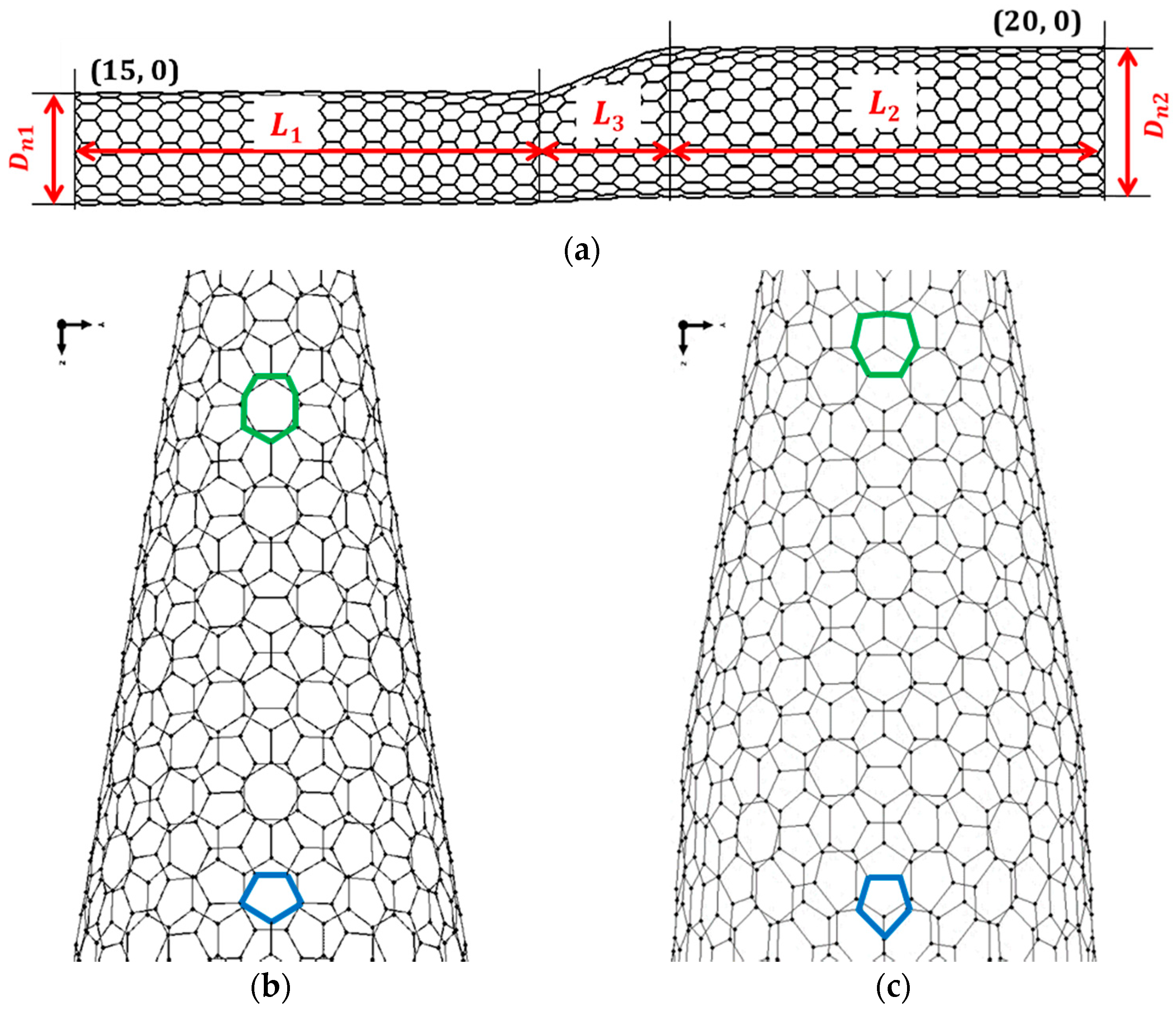
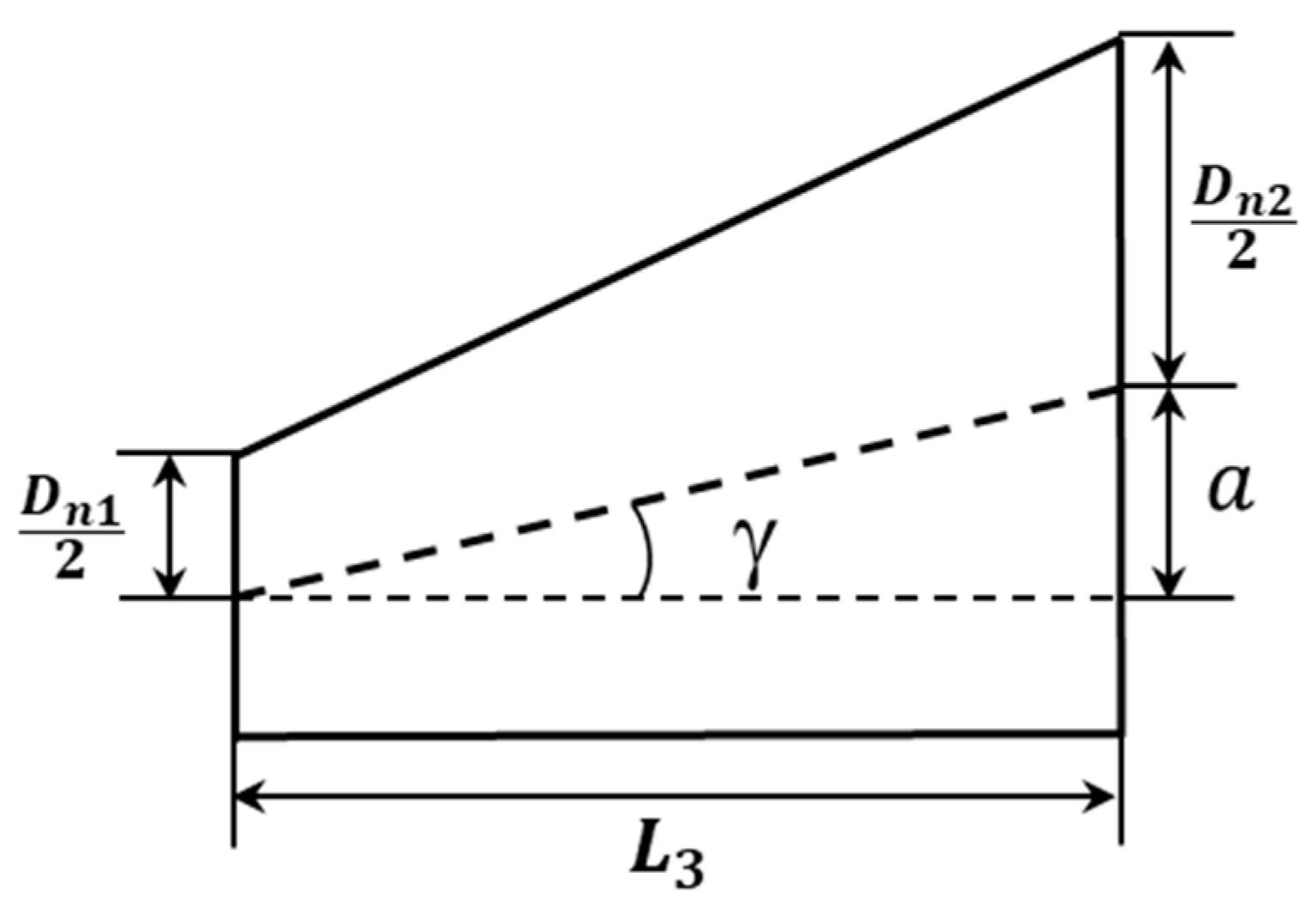
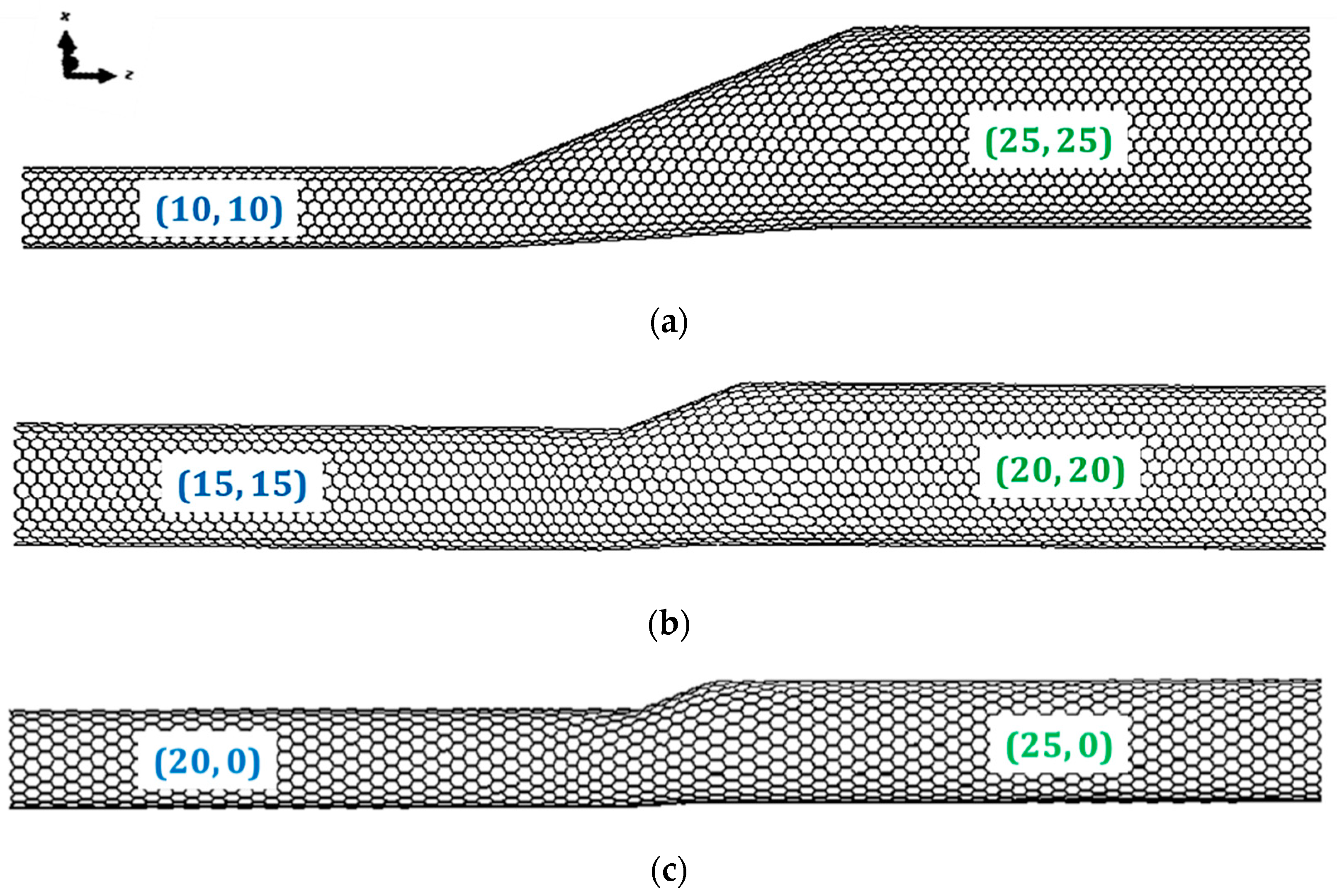
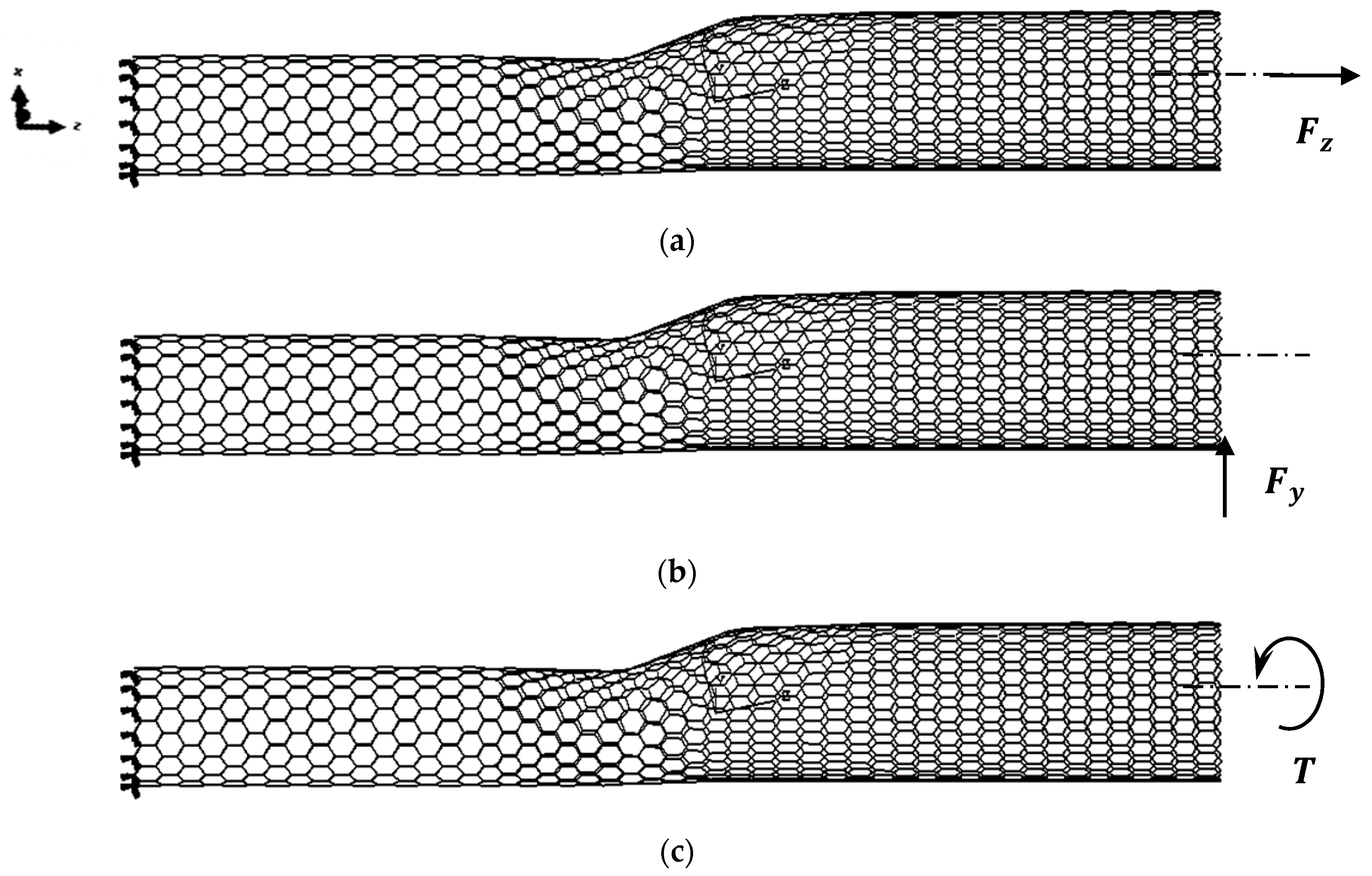
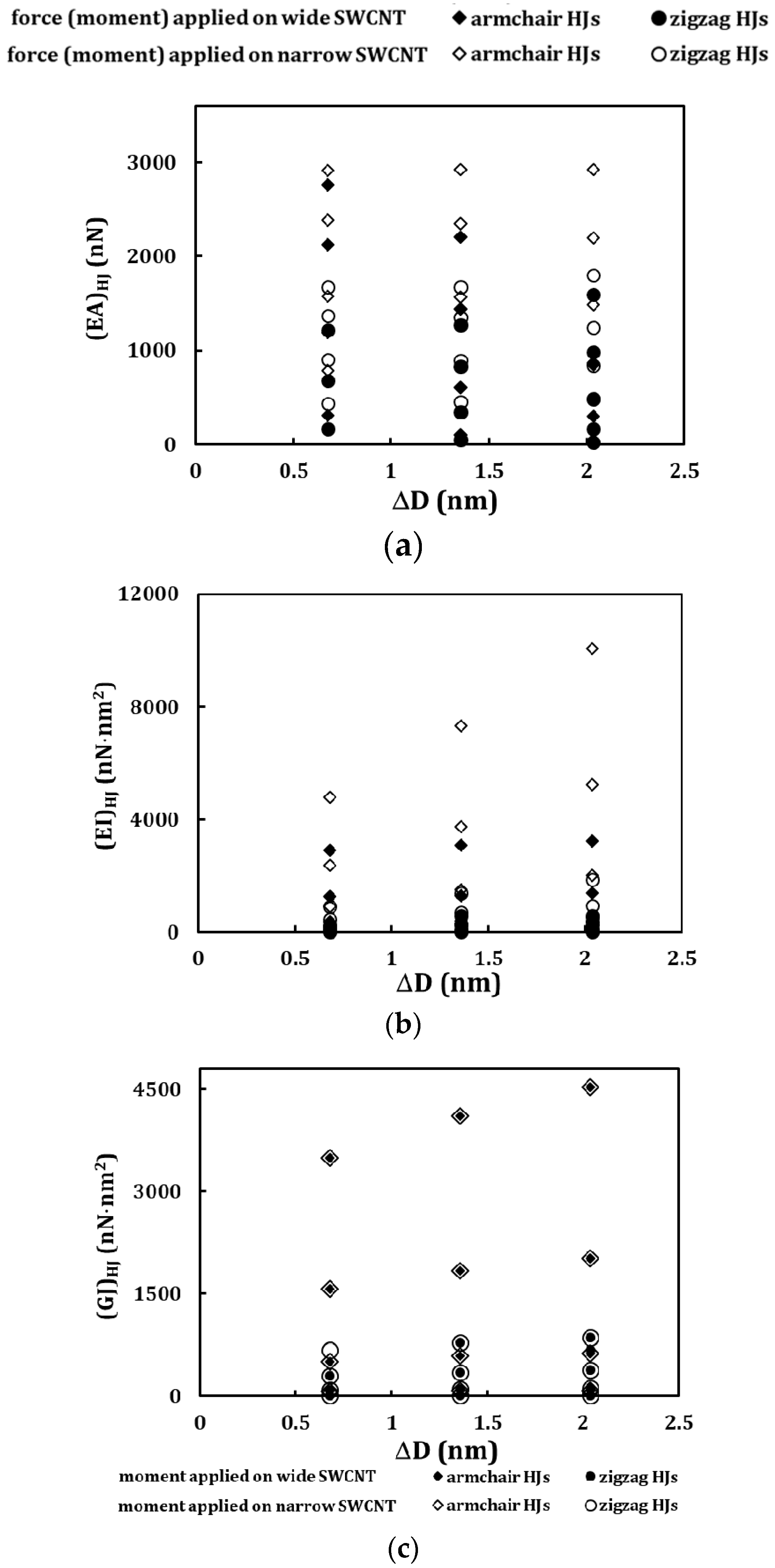
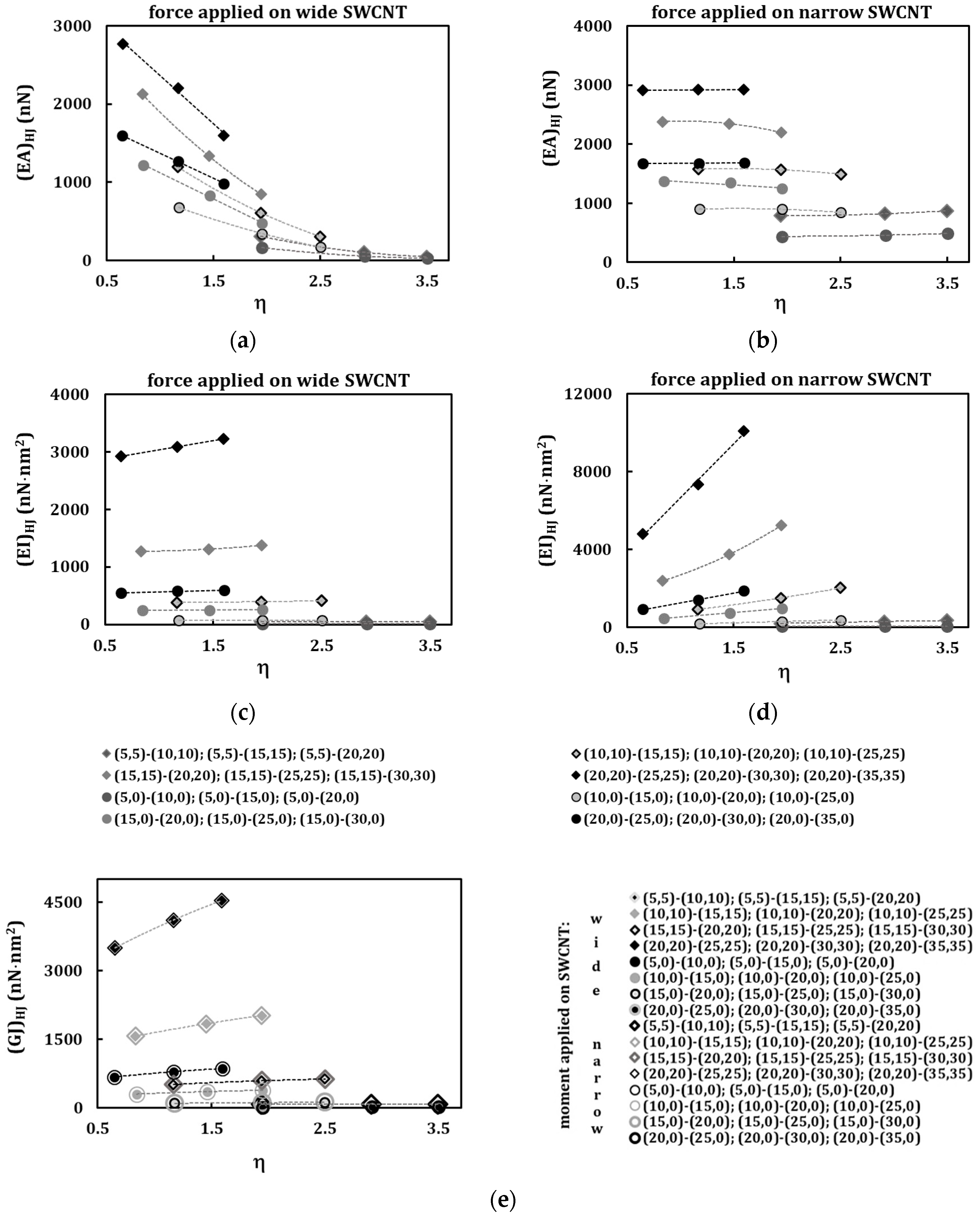
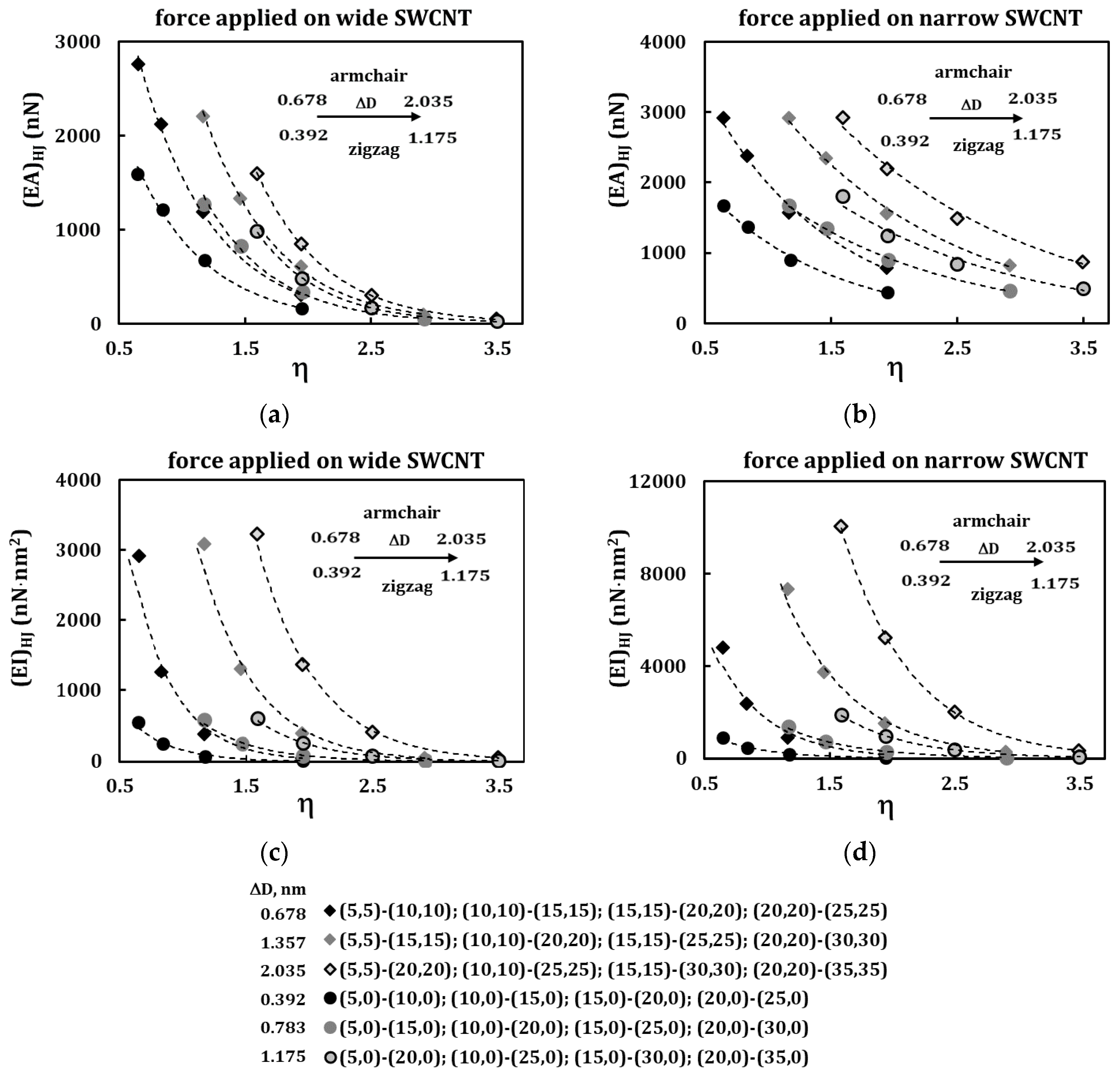
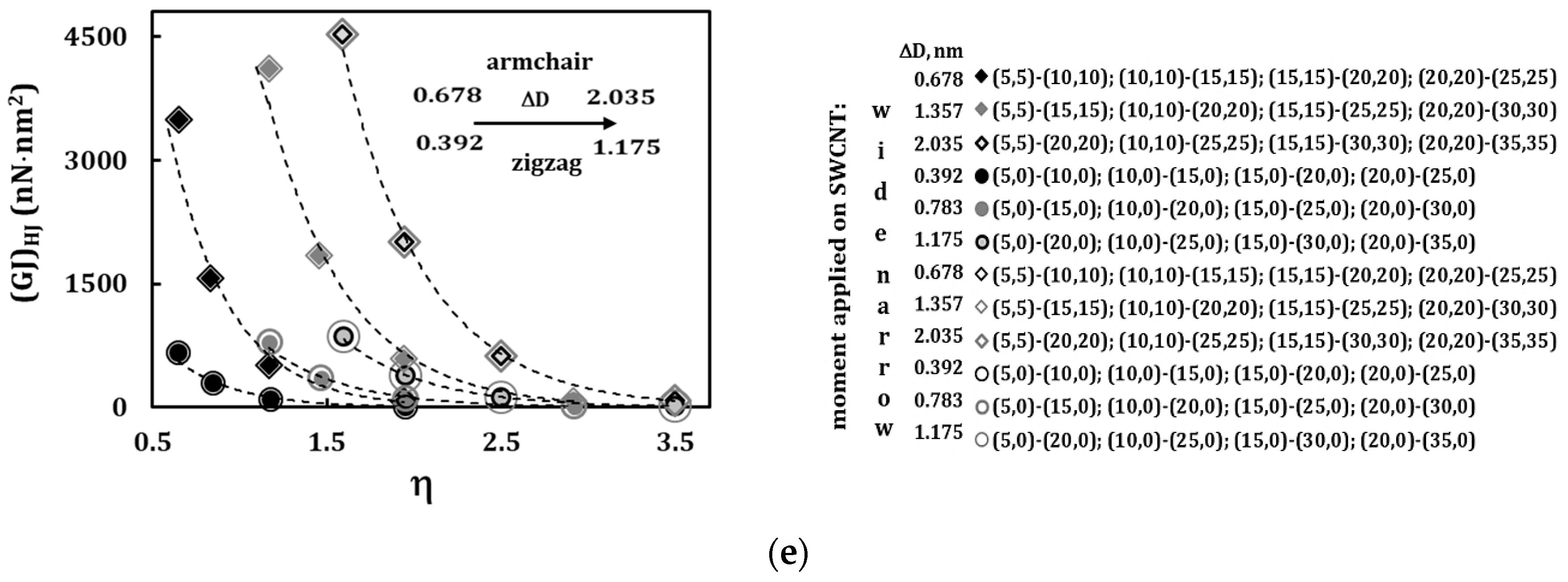
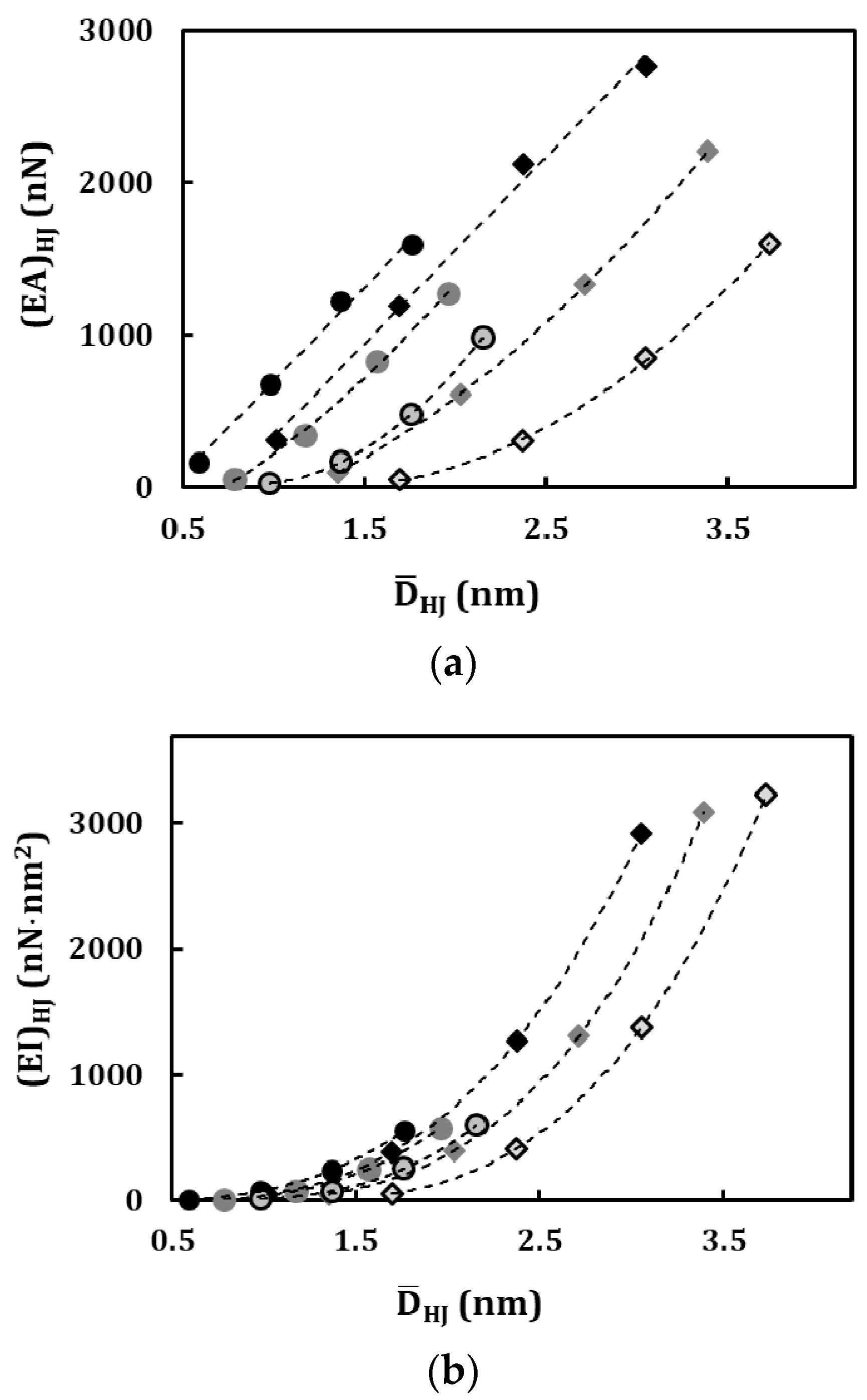
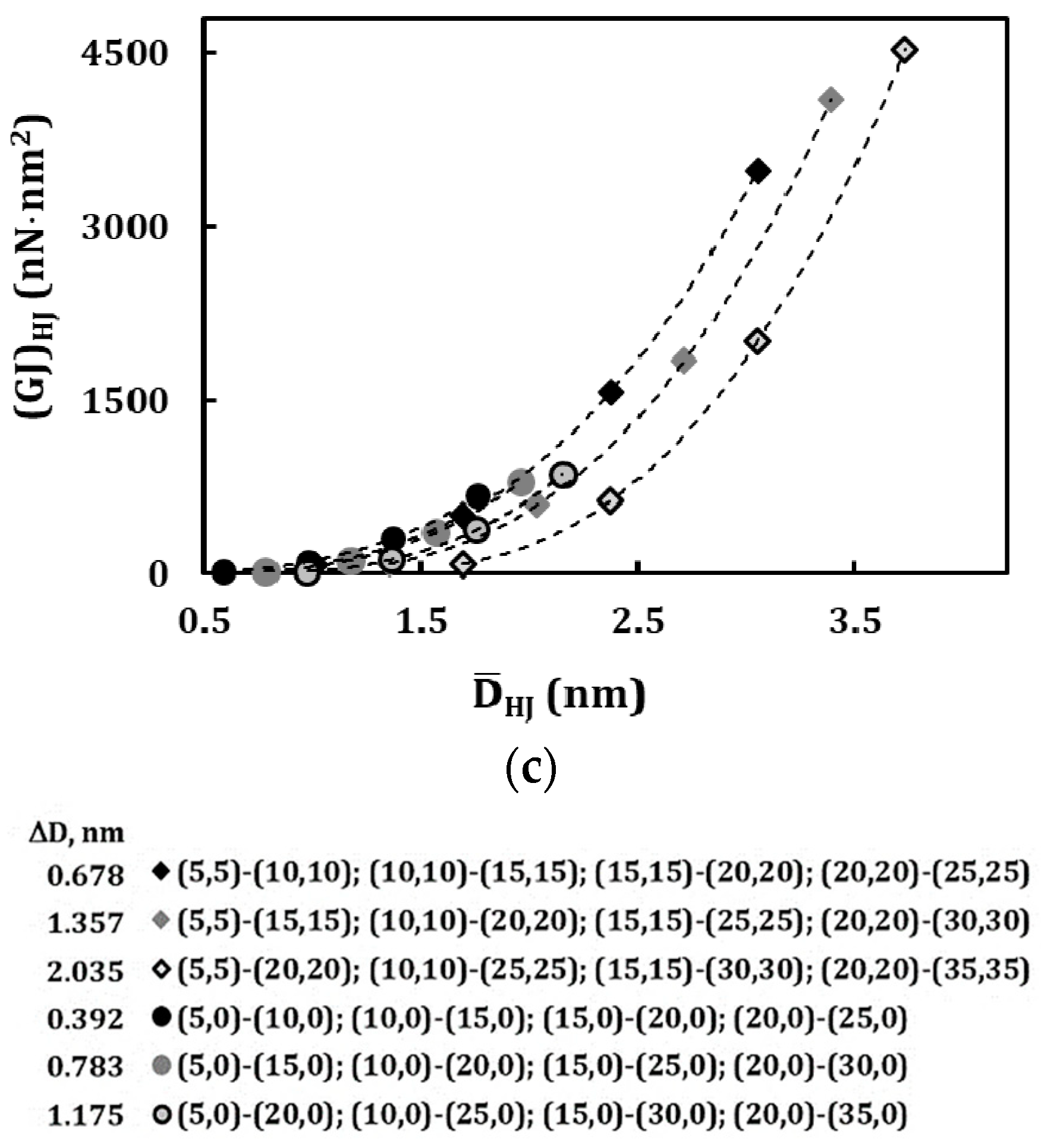
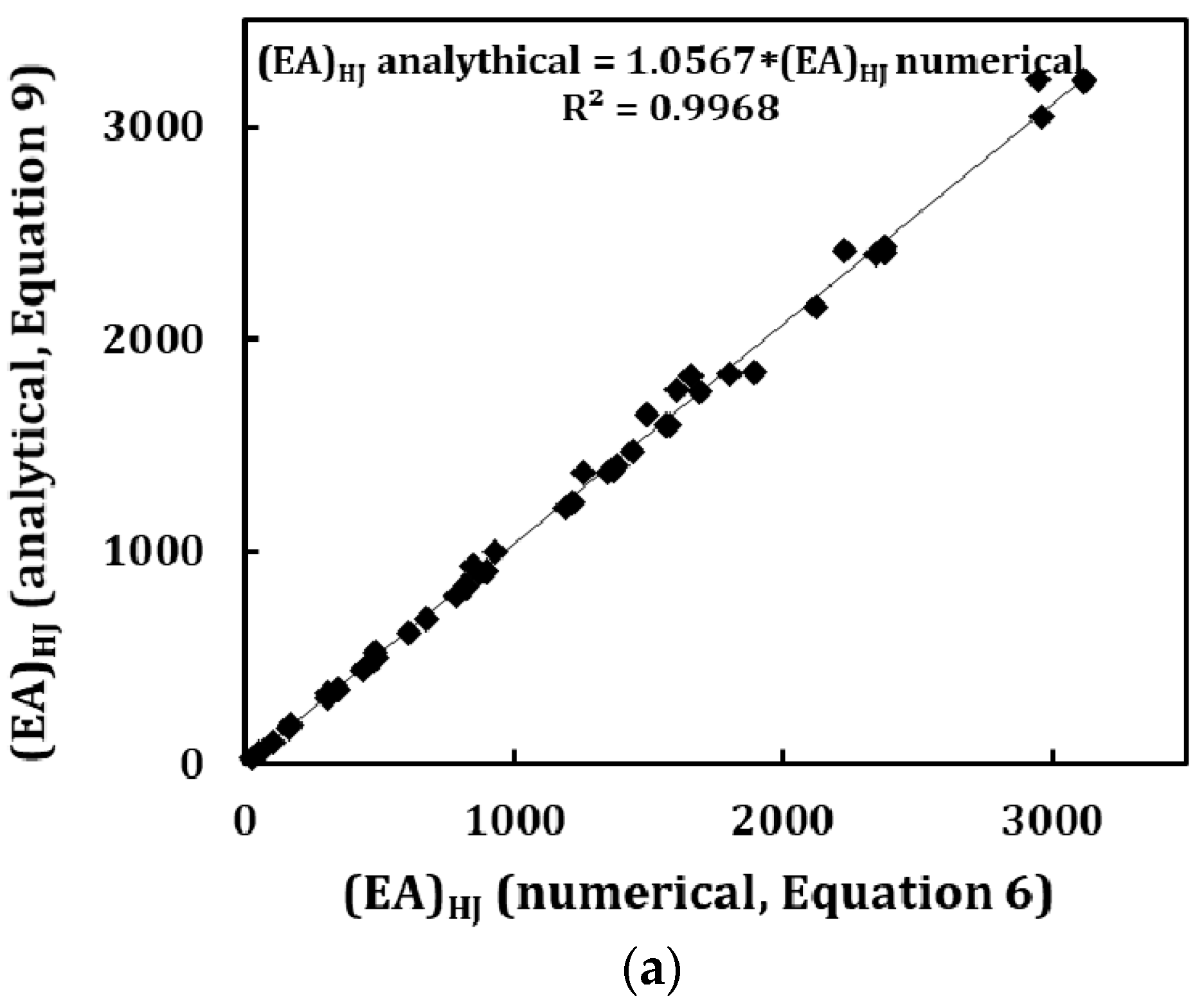
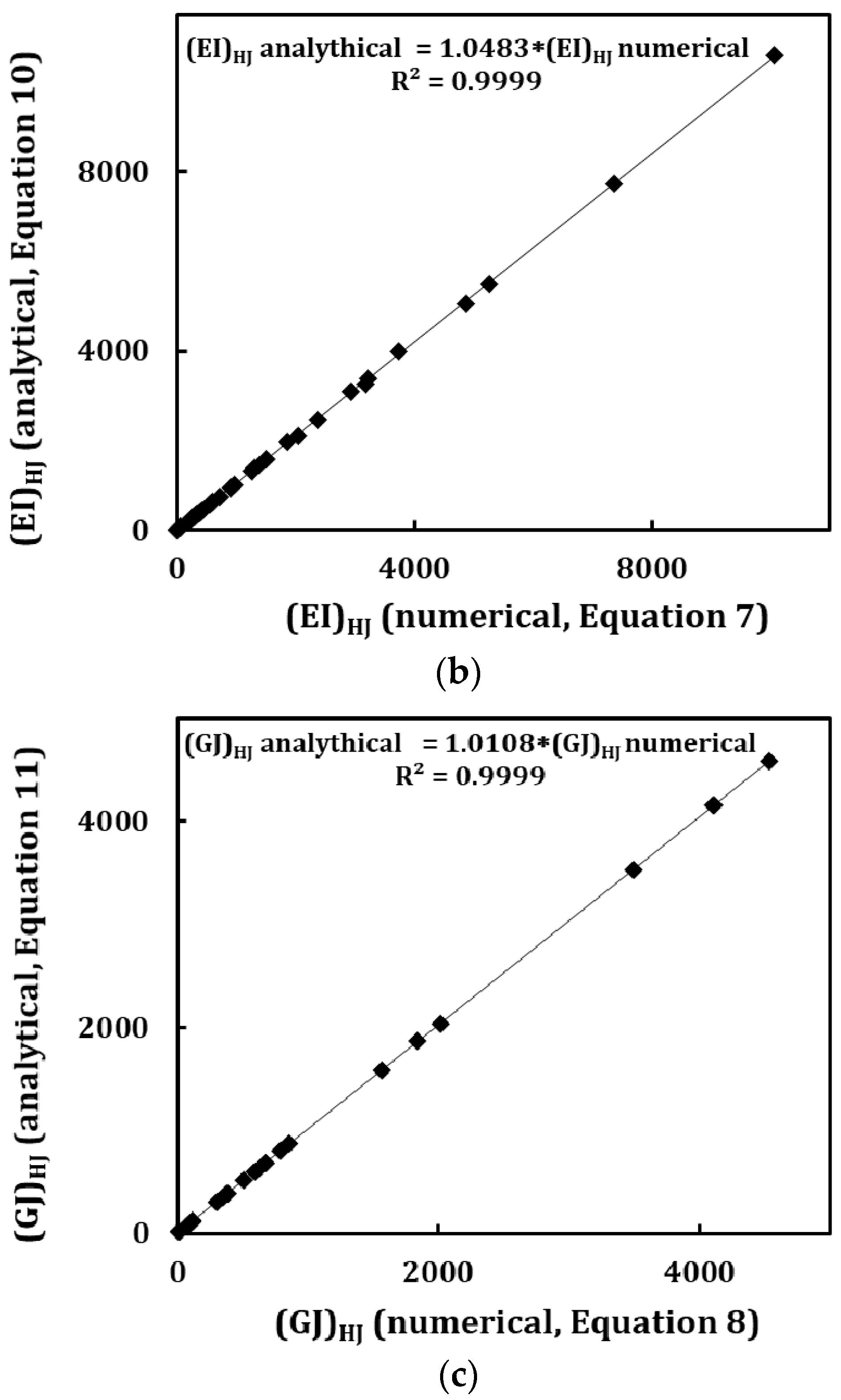
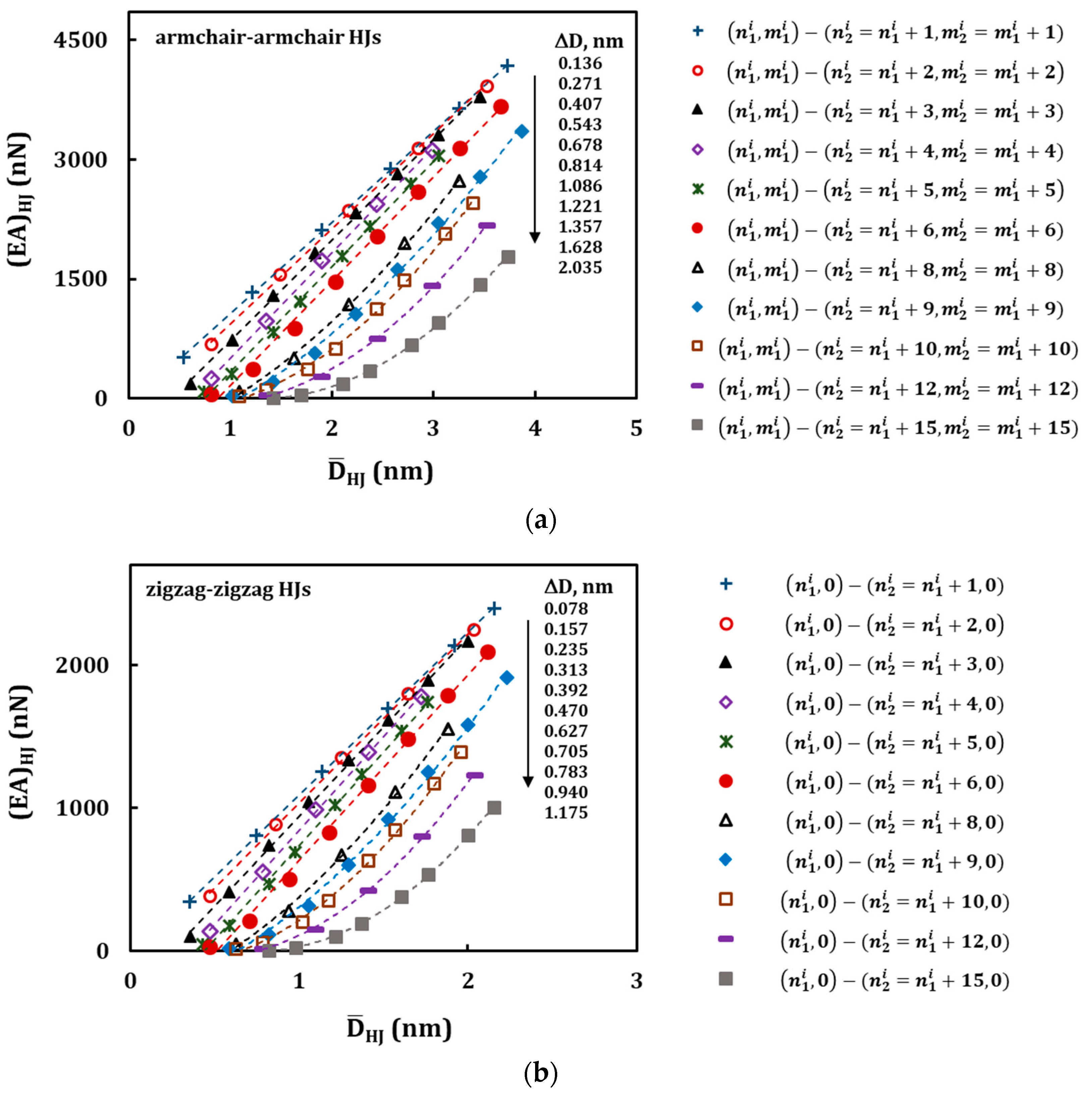

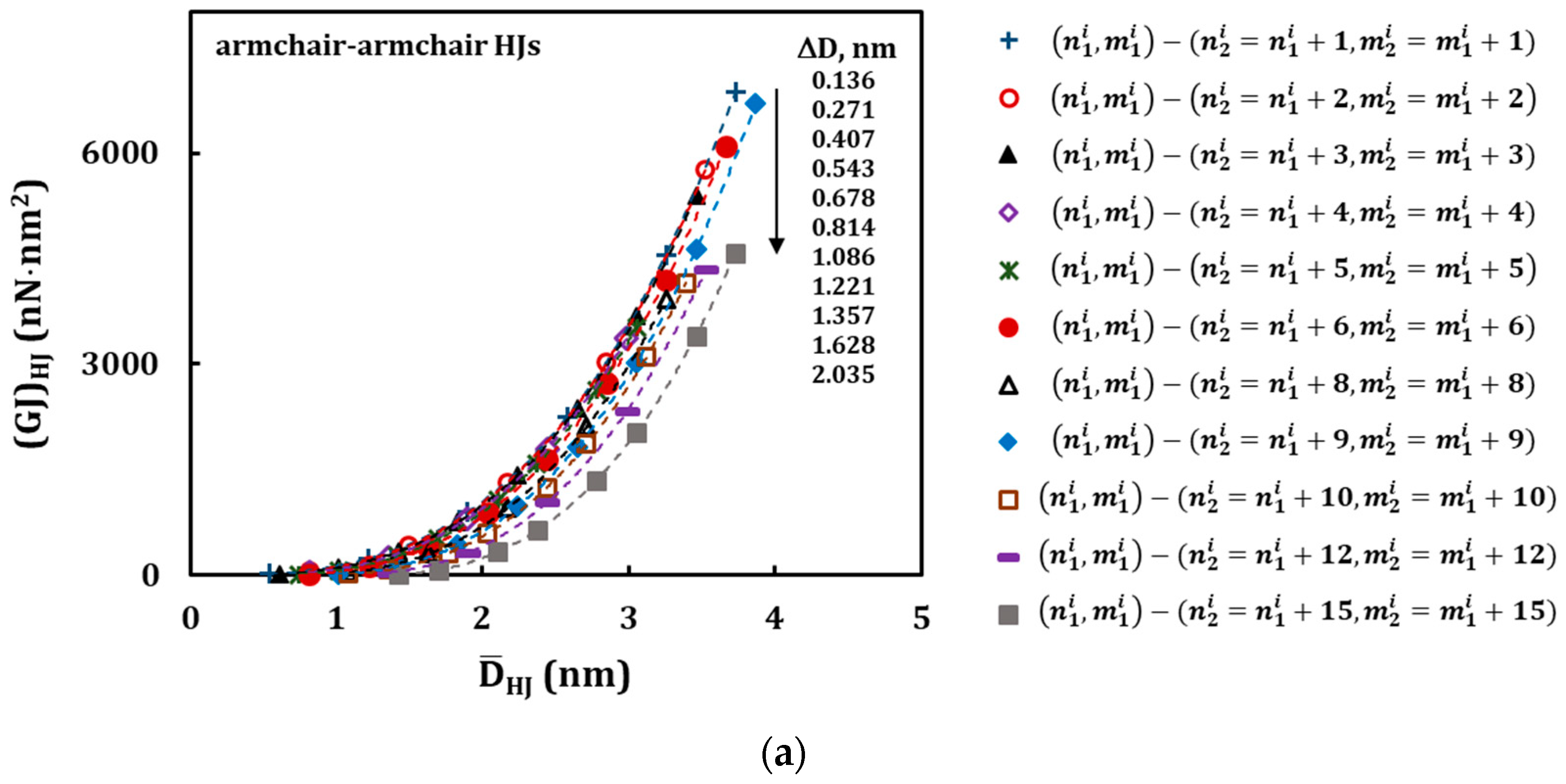
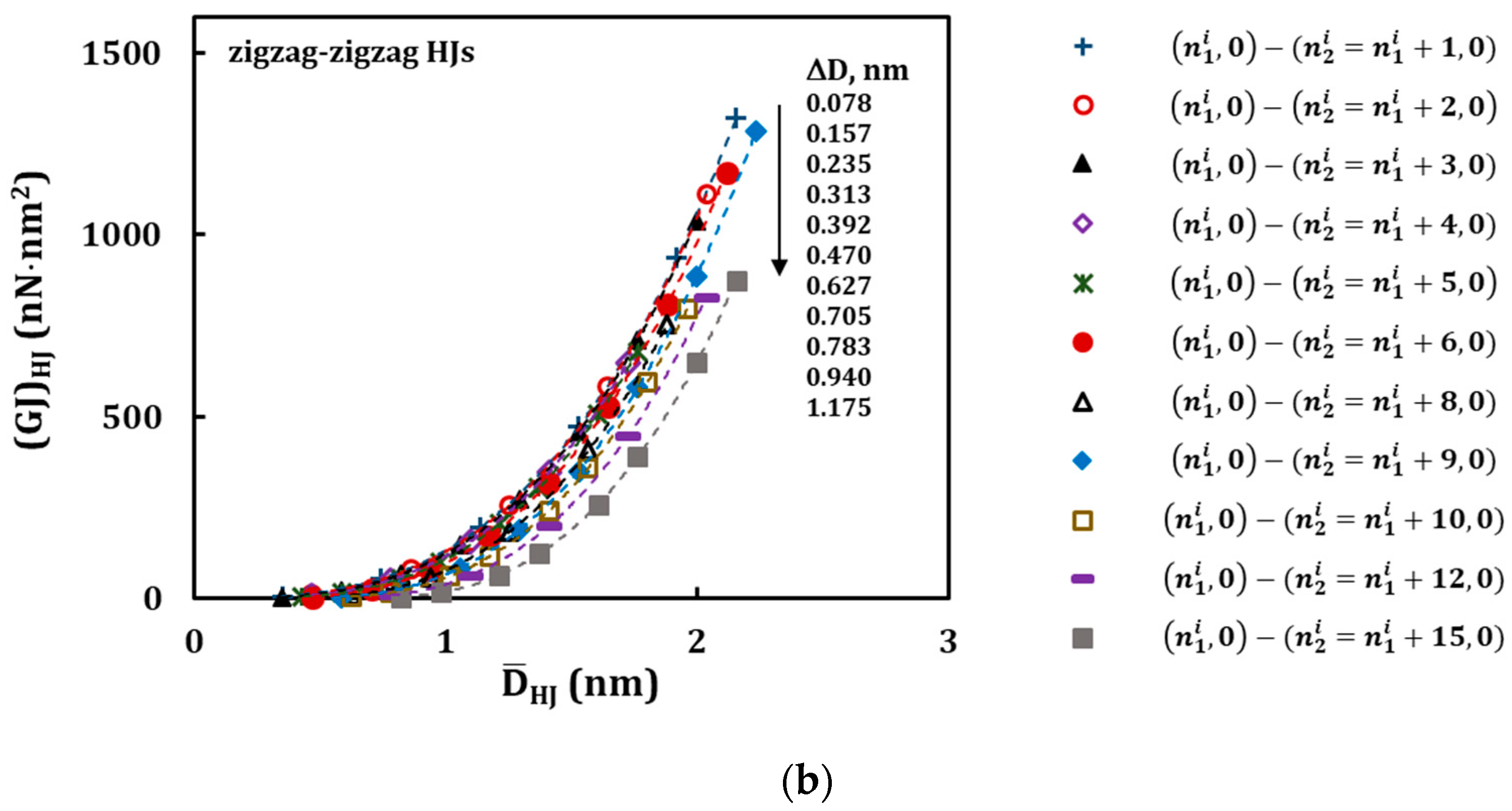
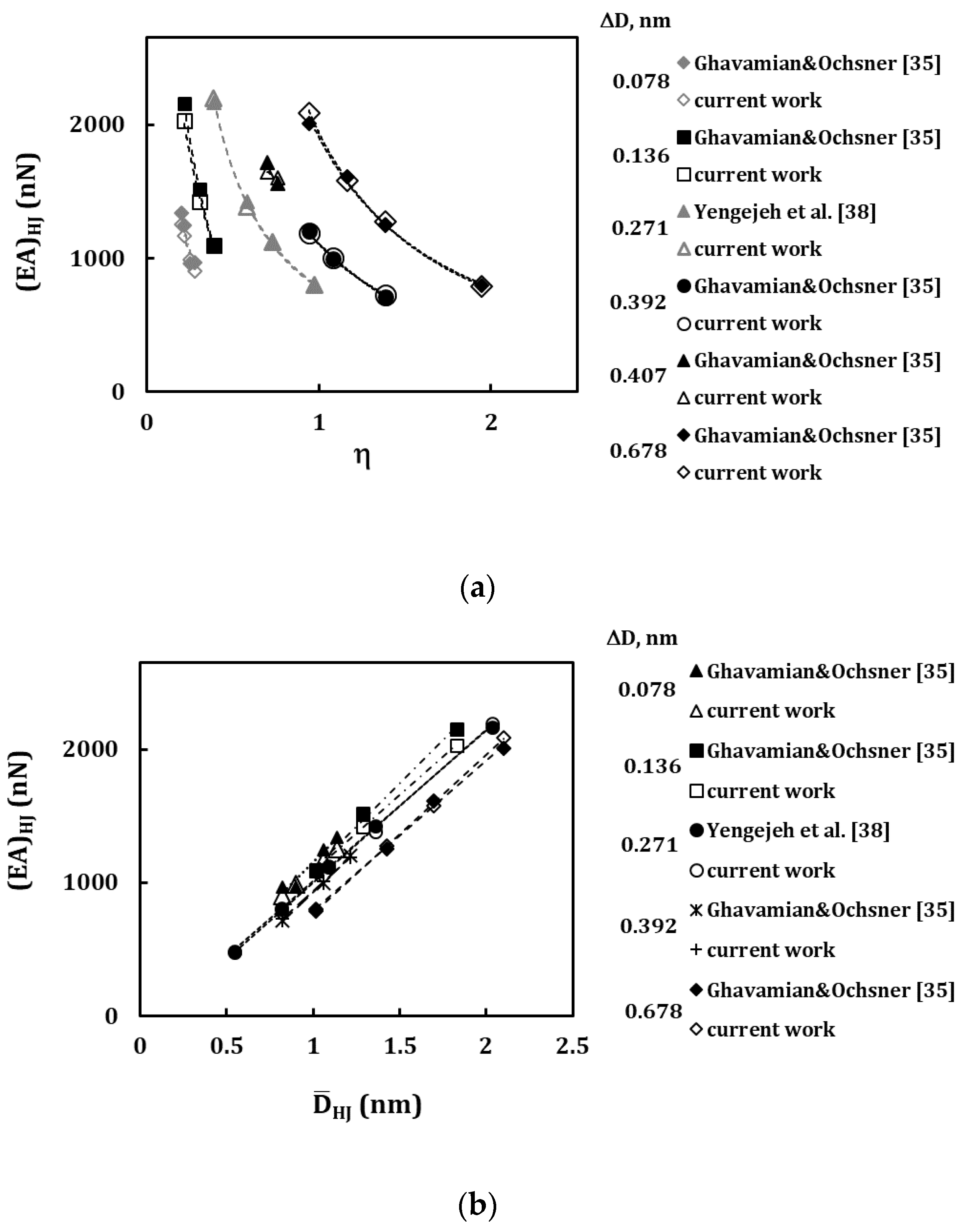
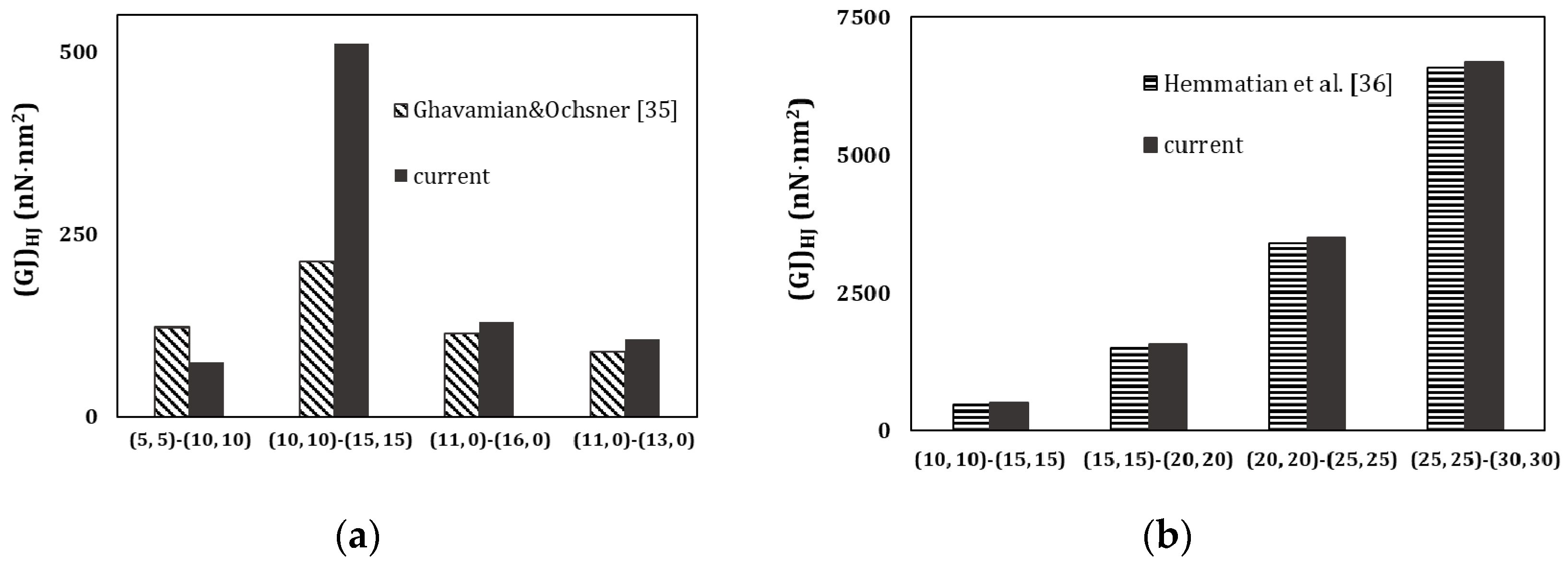
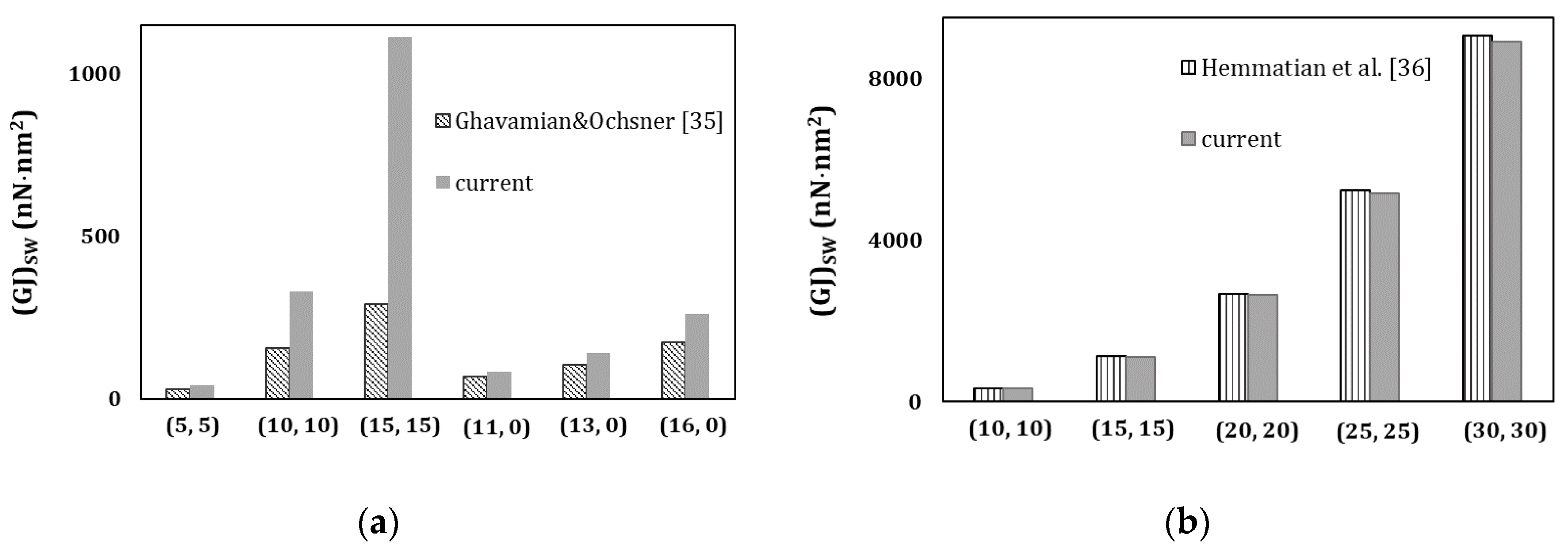
| Parameter | Value | Formulation |
|---|---|---|
| Bond stretching force constant, kr [43] | 6.52 × 10−7 N·nm−1 | – |
| Bond bending force constant, kθ [43] | 8.76 × 10−10 N·nm·rad−2 | – |
| Torsional resistance force constant, kτ [43,44] | 2.78 × 10−10 N·nm·rad−2 | – |
| C–C bond/beam length (l = ac-c) | 0.1421 nm | – |
| Diameter (d) | 0.147 nm | |
| Cross section area, Ab | 0.01688 nm2 | |
| Moment of inertia, Ib | 2.269 × 10−5 nm4 | |
| Polar moment of inertia, Jb | 4.53 7 × 10−5 nm4 | |
| Young’s modulus, Eb | 5488 GPa | |
| Shear modulus, Gb | 870.7 GPa | |
| Rigidity, EbAb | 92.65 nN | |
| Rigidity, EbIb | 0.1245 nN·nm2 | |
| Rigidity, GbJb | 0.0395 nN·nm2 |
| HJ | (n1, m1)–(n2, m2) | ΔD, nm | η | L1, nm | L2, nm | L3, nm | |
|---|---|---|---|---|---|---|---|
| armchair–armchair | (5, 5)–(10, 10) | 0.678 | 1.018 | 1.940 | 100.01 | 99.95 | 1.97 |
| (5, 5)–(15, 15) | 1.357 | 1.357 | 2.912 | 100.01 | 100.02 | 3.95 | |
| (5, 5)–(20, 20) | 2.035 | 1.696 | 3.496 | 100.01 | 100.04 | 5.93 | |
| (10, 10)–(15, 15) | 0.678 | 1.696 | 1.166 | 100.06 | 100.00 | 1.98 | |
| (10, 10)–(20, 20) | 1.357 | 2.035 | 1.943 | 100.05 | 100.07 | 3.96 | |
| (10, 10)–(25, 25) | 2.035 | 2.375 | 2.501 | 100.04 | 100.06 | 5.94 | |
| (15, 15)–(20, 20) | 0.678 | 2.375 | 0.833 | 100.00 | 100.01 | 1.98 | |
| (15, 15)–(25, 25) | 1.357 | 2.714 | 1.458 | 100.02 | 99.98 | 3.96 | |
| (15, 15)–(30, 30) | 2.035 | 3.053 | 1.946 | 100.02 | 99.97 | 5.94 | |
| (20, 20)–(25, 25) | 0.678 | 3.053 | 0.649 | 100.00 | 101.99 | 1.98 | |
| (20, 20)–(30, 30) | 1.357 | 3.392 | 1.167 | 100.02 | 99.99 | 3.96 | |
| (20, 20)–(35, 35) | 2.035 | 3.732 | 1.592 | 100.04 | 99.97 | 5.94 | |
| zigzag–zigzag | (5, 0)–(10, 0) | 0.392 | 0.588 | 1.950 | 99.92 | 99.96 | 1.15 |
| (5, 0)–(15, 15) | 0.783 | 0.783 | 2.918 | 100.11 | 100.13 | 2.29 | |
| (5, 0)–(20, 20) | 1.175 | 0.979 | 3.500 | 100.12 | 100.10 | 3.43 | |
| (10, 0)–(15, 0) | 0.392 | 0.979 | 1.177 | 100.14 | 100.12 | 1.15 | |
| (10, 0)–(20, 0) | 0.783 | 1.175 | 1.952 | 99.97 | 100.10 | 2.29 | |
| (10, 0)–(25, 0) | 1.175 | 1.371 | 2.502 | 99.96 | 100.10 | 3.43 | |
| (15, 0)–(20, 0) | 0.392 | 1.371 | 0.843 | 100.03 | 100.00 | 1.16 | |
| (15, 0)–(25, 0) | 0.783 | 1.567 | 1.466 | 100.02 | 99.97 | 2.30 | |
| (15, 0)–(30, 0) | 1.175 | 1.763 | 1.952 | 100.01 | 99.94 | 3.44 | |
| (20, 0)–(25, 0) | 0.392 | 1.763 | 0.647 | 99.94 | 104.61 | 1.14 | |
| (20, 0)–(30, 0) | 0.783 | 1.959 | 1.169 | 99.92 | 102.34 | 2.29 | |
| (20, 0)–(35, 0) | 1.175 | 2.154 | 1.597 | 99.92 | 100.05 | 3.44 |
| (n1, m1)–(n2, m2) | C * | ΔD, nm | (n1, m1)–(n2, m2) | C * | ΔD, nm | ||
|---|---|---|---|---|---|---|---|
| (4, 4)–(5, 5) | 1 | 0.136 | 0.543 | (5, 5)–(7, 7) | 2 | 0.271 | 0.814 |
| (9, 9)–(10, 10) | 1.221 | ||||||
| (14, 14)–(15, 15) | 1.900 | (10, 10)–(12, 12) | 1.493 | ||||
| (19, 19)–(20, 20) | 2.578 | (15, 15)–(17, 17) | 2.171 | ||||
| (24, 24)–(25, 25) | 3.257 | (20, 20)–(22, 22) | 2.850 | ||||
| (27, 27)–(28, 28) | 3.732 | (25, 25)–(27, 27) | 3.528 | ||||
| (3, 3)–(6, 6) | 3 | 0.407 | 0.611 | (4, 4)–(8, 8) | 4 | 0.543 | 0.814 |
| (6, 6)–(9, 9) | 1.018 | ||||||
| (9, 9)–(12, 12) | 1.425 | (8. 8)–(12, 12) | 1.357 | ||||
| (12, 12)–(15, 15) | 1.832 | (12, 12)–(16, 16) | 1.900 | ||||
| (15, 15)–(18, 18) | 2.239 | ||||||
| (18, 18)–(21, 21) | 2.646 | (16, 16)–(20, 20) | 2.443 | ||||
| (21, 21)–(24, 24) | 3.053 | (20, 20)–(24, 24) | 2.985 | ||||
| (24, 24)–(27, 27) | 3.460 | ||||||
| (3, 3)–(8, 8) | 5 | 0.678 | 0.746 | (3, 3)–(9, 9) | 6 | 0.814 | 0.814 |
| (6, 6)–(12, 12) | 1.221 | ||||||
| (8, 8)–(13, 13) | 1.425 | (9, 9)–(15, 15) | 1.628 | ||||
| (12, 12)–(18, 18) | 2.035 | ||||||
| (13, 13)–(18, 18) | 2.103 | (15, 15)–(21, 21) | 2.443 | ||||
| (18, 18)–(24, 24) | 2.850 | ||||||
| (18, 18)–(23, 23) | 2.782 | (21, 21)–(27, 27) | 3.257 | ||||
| (24, 24)–(30, 30) | 3.664 | ||||||
| (4, 4)–(12, 12) | 8 | 1.086 | 1.086 | (3, 3)–(12, 12) | 9 | 1.221 | 1.018 |
| (6, 6)–(15, 15) | 1.425 | ||||||
| (8, 8)–(16, 16) | 1.628 | (9, 9)–(18, 18) | 1.832 | ||||
| (12, 12)–(20, 20) | 2.171 | (12, 12)–(21, 21) | 2.239 | ||||
| (15, 15)–(24, 24) | 2.646 | ||||||
| (16, 16)–(24, 24) | 2.714 | (18, 18)–(27, 27) | 3.053 | ||||
| (20, 20)–(28, 28) | 3.257 | (21, 21)–(30, 30) | 3.460 | ||||
| (24, 24)–(33, 33) | 3.867 | ||||||
| (3, 3)–(13, 13) | 10 | 1.357 | 1.086 | (4, 4)–(16, 16) | 12 | 1.628 | 1.357 |
| (8, 8)–(20, 20) | 1.900 | ||||||
| (8, 8)–(18, 18) | 1.764 | (12, 12)–(24, 24) | 2.443 | ||||
| (13, 13)–(23, 23) | 2.443 | (16, 16)–(28, 28) | 2.985 | ||||
| (18, 18)–(28, 28) | 3.121 | (20, 20)–(32, 32) | 3.528 | ||||
| (3, 3)–(18, 18) | 15 | 2.035 | 1.425 | – | – | – | – |
| (8, 8)–(23, 23) | 2.103 | – | – | – | – | ||
| (13, 13)–(28, 28) | 2.782 | – | – | – | – | ||
| (18, 18)–(33, 33) | 3.460 | – | – | – | – |
| (n1, 0)–(n2, 0) | C * | ΔD, nm | (n1, 0)–(n2, 0) | C * | ΔD, nm | ||
|---|---|---|---|---|---|---|---|
| (4, 0)–(5, 0) | 1 | 0.078 | 0.353 | (5, 0)–(7, 0) | 2 | 0.157 | 0.470 |
| (9, 0)–(10, 0) | 0.744 | ||||||
| (14, 0)–(15, 0) | 1.136 | (10, 0)–(12, 0) | 0.862 | ||||
| (19, 0)–(20, 0) | 1.528 | (15, 0)–(17, 0) | 1.254 | ||||
| (24, 0)–(25, 0) | 1.919 | (20, 0)–(22, 0) | 1.645 | ||||
| (27, 0)–(28, 0) | 2.154 | (25, 0)–(27, 0) | 2.037 | ||||
| (3, 0)–(6, 0) | 3 | 0.235 | 0.353 | (4, 0)–(8, 0) | 4 | 0.133 | 0.470 |
| (6, 0)–(9, 0) | 0.588 | ||||||
| (9, 0)–(12, 0) | 0.823 | (8. 0)–(12, 0) | 0.783 | ||||
| (12, 0)–(15, 0) | 1.058 | (12, 0)–(16, 0) | 1.097 | ||||
| (15, 0)–(18, 0) | 1.293 | ||||||
| (18, 0)–(21, 0) | 1.528 | (16, 0)–(20, 0) | 1.410 | ||||
| (21, 0)–(24, 0) | 1.763 | (20, 0)–(24, 0) | 1.724 | ||||
| (24, 0)–(27, 0) | 1.998 | ||||||
| (3, 0)–(8, 0) | 5 | 0.392 | 0.431 | (3, 0)–(9, 0) | 6 | 0.470 | 0.470 |
| (6, 0)–(12, 0) | 0.705 | ||||||
| (8, 0)–(13, 0) | 0.823 | (9, 0)–(15, 0) | 0.940 | ||||
| (12, 0)–(18, 0) | 1.175 | ||||||
| (13, 0)–(18, 0) | 1.214 | (15, 0)–(21, 0) | 1.410 | ||||
| (18, 0)–(24, 0) | 1.645 | ||||||
| (18, 0)–(23, 0) | 1.606 | (21, 0)–(27, 0) | 1.880 | ||||
| (24, 0)–(30, 0) | 2.115 | ||||||
| (4, 0)–(12, 12) | 8 | 0.627 | 0.627 | (3, 0)–(12, 0) | 9 | 0.705 | 0.588 |
| (6, 0)–(15, 0) | 0.823 | ||||||
| (8, 0)–(16, 16) | 0.940 | (9, 0)–(18, 0) | 1.058 | ||||
| (12, 0)–(20, 20) | 1.254 | (12, 0)–(21, 0) | 1.293 | ||||
| (15, 0)–(24, 0) | 1.528 | ||||||
| (16, 0)–(24, 24) | 1.567 | (18, 0)–(27, 0) | 1.763 | ||||
| (20, 0)–(28, 28) | 1.880 | (21, 0)–(30, 0) | 1.998 | ||||
| (24, 0)–(33, 0) | 2.233 | ||||||
| (3, 0)–(13, 0) | 10 | 0.783 | 0.627 | (4, 0)–(16, 0) | 12 | 0.940 | 0.783 |
| (8, 0)–(20, 0) | 1.097 | ||||||
| (8, 0)–(18, 0) | 1.018 | (12, 0)–(24, 0) | 1.410 | ||||
| (13, 0)–(23, 0) | 1.410 | (16, 0)–(28, 0) | 1.724 | ||||
| (18, 0)–(28, 0) | 1.802 | (20, 0)–(32, 0) | 2.037 | ||||
| (3, 0)–(18, 0) | 15 | 1.175 | 0.823 | - | |||
| (8, 0)–(23, 0) | 1.214 | ||||||
| (13, 0)–(28, 0) | 1.606 | ||||||
| (18, 0)–(33, 0) | 1.998 |
| Reference | Method | Type of HJs | Young’s Modulus, EHJ, TPa | Shear Modulus, GHJ, TPa |
|---|---|---|---|---|
| Qin et al. [30] | Molecular dynamics (MD): Tersoff–Brenner potential | armchair–armchair sequence with narrow SWCNT (5, 5) | 0.775 * | – |
| zigzag–zigzag sequence with narrow SWCNT (9, 0) | 0.795 * | – | ||
| Scarpa et al. [34] | Nanoscale continuum modelling (NCM): linear beams | armchair–armchair (5, 5)–(10, 10) | 1.010 | – |
| zigzag–zigzag (9, 9)–(14, 14) | 0.945 | – | ||
| Hemmatian et al. [36] | armchair–armchair (5, 5)–(10, 10), (10, 10)–(15, 15)…(25, 25)–(30, 30) | 1.109 * | 0.344 * | |
| Yengejeh et al. [38] | armchair–armchair (5, 5)–(10, 10) and a sequence with ΔD = 0.271 nm | 0.947 * | – | |
| zigzag–zigzag (11, 0)–(12, 0),(9, 0)–(12, 0), (12, 0)–(16, 0) | 0.982 * | – | ||
| Ghavamian and Ochsner [35], Ghavamian et al. [27] | armchair–armchair composed by SWCNTs in a range of (7, 7) to (18, 18) | 0.927 * | 0.180 * | |
| zigzag–zigzag composed by SWCNTs in a range of (6, 0) to (18, 0) | 0.939 * | 0.270 * |
| Reference | (n1, m1)–(n2, m2) (n1, 0)–(n2, 0) | η | ΔD, nm | EHJ, Tpa Reference | (EA)HJ, nN | Difference, % | ||
|---|---|---|---|---|---|---|---|---|
| Reference + Equation (21) | Current | |||||||
| Yengejeh et al. [38] | (3, 3)–(5, 5) | 1.458 | 0.271 | 0.543 | 0.889 | 483.20 | 474.16 | 1.87 |
| (5, 5)–(7, 7) | 0.972 | 0.814 | 0.953 | 805.76 | 796.82 | 1.11 | ||
| (7, 7)–(9, 9) | 0.729 | 1.086 | 0.981 | 1119.73 | 1118.61 | 0.10 | ||
| (9, 9)–(11, 11) | 1.944 | 1.357 | 0.992 | 1423.45 | 1381.59 | 2.94 | ||
| (14, 14)–(16, 16) | 0.583 | 2.035 | 1.001 | 2166.63 | 2196.91 | 1.40 | ||
| (5, 5)–(10, 10) | 0.389 | 0.678 | 1.018 | 0.865 | 835.83 | 786.07 | 5.95 | |
| (9, 0)–(12, 0) | 0.833 | 0.235 | 0.823 | 0.960 | 826.30 | 823.72 | 0.31 | |
| (12, 0)–(16, 0) | 0.833 | 0.313 | 1.097 | 0.962 | 1104.03 | 1099.54 | 0.41 | |
| (11, 0)–(12, 0) | 0.254 | 0.078 | 0.901 | 1.023 | 982.62 | 987.69 | 0.52 | |
| Ghavamian and Ochsner [35] | (8, 8)–(15, 15) | 1.775 | 0.950 | 1.560 | 0.765 | 1275.13 | 1274.97 | 0.01 |
| (5, 5)–(10, 10) | 1.944 | 0.678 | 1.018 | 0.735 | 798.99 | 786.07 | 1.62 | |
| (8, 8)–(13, 13) | 1.388 | 1.425 | 0.825 | 1255.56 | 1273.08 | 1.40 | ||
| (10, 10)–(15, 15) | 1.166 | 1.696 | 0.889 | 1610.67 | 1577.30 | 2.07 | ||
| (13, 13)–(18, 18) | 0.941 | 2.103 | 0.895 | 2010.71 | 2085.06 | 3.70 | ||
| (10, 10)–(13, 13) | 0.761 | 0.407 | 1.560 | 0.935 | 1558.49 | 1600.93 | 2.72 | |
| (11, 11)–(14, 14) | 0.700 | 1.696 | 0.945 | 1712.13 | 1647.32 | 3.79 | ||
| (7, 7)–(8, 8) | 0.389 | 0.136 | 1.018 | 1.001 | 1088.15 | 1096.29 | 0.75 | |
| (9, 9)–(10, 10) | 0.307 | 1.289 | 1.101 | 1516.02 | 1420.02 | 6.33 | ||
| (13, 13)–(14, 14) | 0.216 | 1.832 | 1.101 | 2154.35 | 2032.28 | 5.67 | ||
| (9, 0)–(19, 0) | 2.083 | 0.783 | 1.097 | 0.678 | 794.31 | 823.08 | 3.62 | |
| (13, 0)–(8, 0) | 1.388 | 0.392 | 0.823 | 0.810 | 711.72 | 726.71 | 2.11 | |
| (11, 0)–(16, 0) | 1.080 | 1.058 | 0.880 | 994.15 | 1004.90 | 1.08 | ||
| (13, 0)–(18, 0) | 0.941 | 1.214 | 0.925 | 1199.80 | 1190.67 | 0.76 | ||
| (11, 0)–(13, 0) | 0.486 | 0.157 | 0.940 | 0.978 | 982.10 | 980.93 | 0.12 | |
| (10, 0)–(11, 0) | 0.278 | 0.078 | 0.823 | 1.101 | 967.41 | 902.63 | 6.70 | |
| (11, 0)–(12, 0) | 0.254 | 0.901 | 1.001 | 963.31 | 987.69 | 2.53 | ||
| (13, 0)–(14, 0) | 0.216 | 1.058 | 1.101 | 1243.81 | 1165.03 | 6.33 | ||
| (14, 0)–(15, 0) | 0.201 | 1.136 | 1.101 | 1335.95 | 1253.40 | 6.18 | ||
Publisher’s Note: MDPI stays neutral with regard to jurisdictional claims in published maps and institutional affiliations. |
© 2020 by the authors. Licensee MDPI, Basel, Switzerland. This article is an open access article distributed under the terms and conditions of the Creative Commons Attribution (CC BY) license (http://creativecommons.org/licenses/by/4.0/).
Share and Cite
Pereira, A.F.G.; Antunes, J.M.; Fernandes, J.V.; Sakharova, N. Mechanical Characterisation of Single-Walled Carbon Nanotube Heterojunctions: Numerical Simulation Study. Materials 2020, 13, 5100. https://doi.org/10.3390/ma13225100
Pereira AFG, Antunes JM, Fernandes JV, Sakharova N. Mechanical Characterisation of Single-Walled Carbon Nanotube Heterojunctions: Numerical Simulation Study. Materials. 2020; 13(22):5100. https://doi.org/10.3390/ma13225100
Chicago/Turabian StylePereira, André F. G., Jorge M. Antunes, José V. Fernandes, and Nataliya Sakharova. 2020. "Mechanical Characterisation of Single-Walled Carbon Nanotube Heterojunctions: Numerical Simulation Study" Materials 13, no. 22: 5100. https://doi.org/10.3390/ma13225100
APA StylePereira, A. F. G., Antunes, J. M., Fernandes, J. V., & Sakharova, N. (2020). Mechanical Characterisation of Single-Walled Carbon Nanotube Heterojunctions: Numerical Simulation Study. Materials, 13(22), 5100. https://doi.org/10.3390/ma13225100






